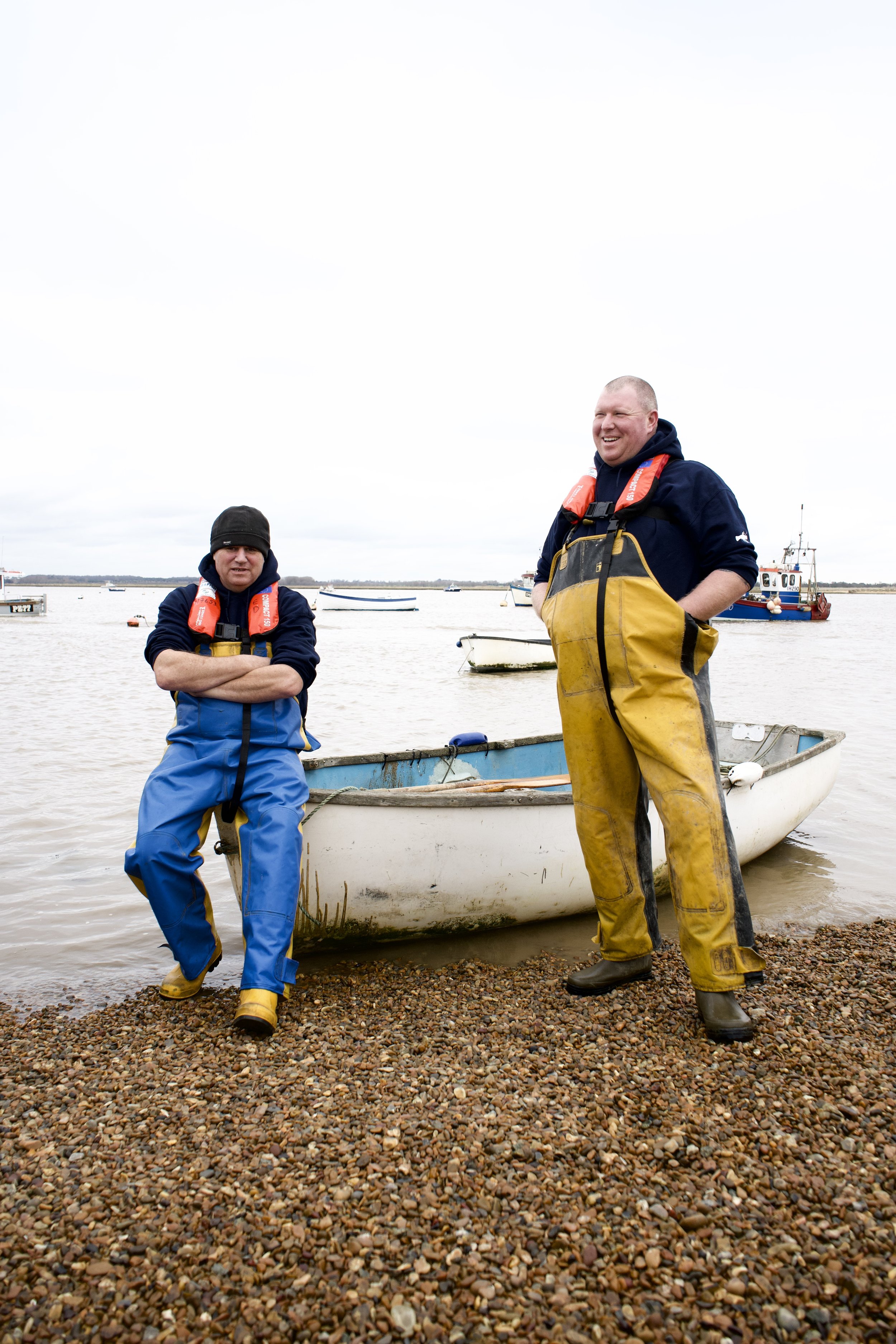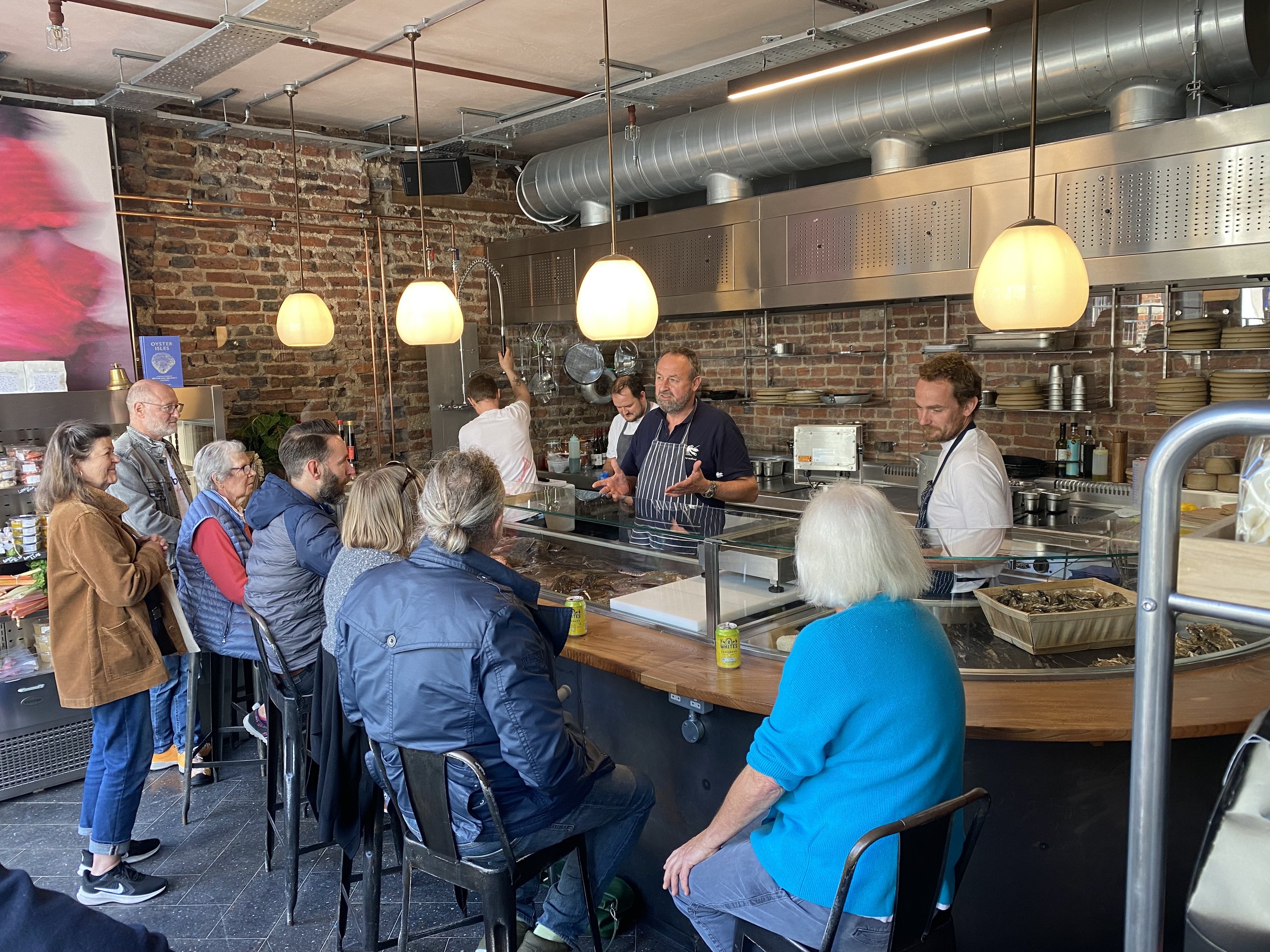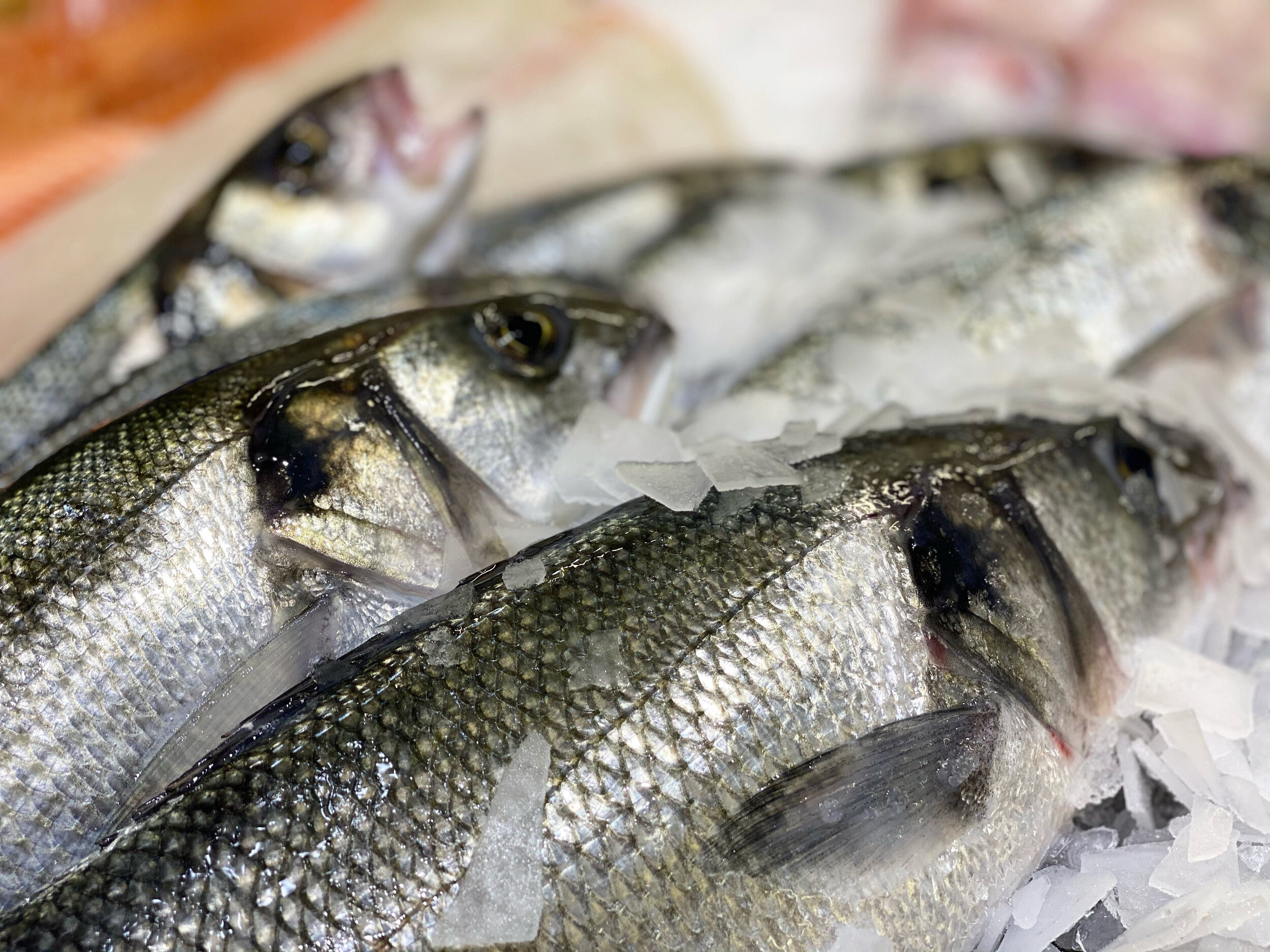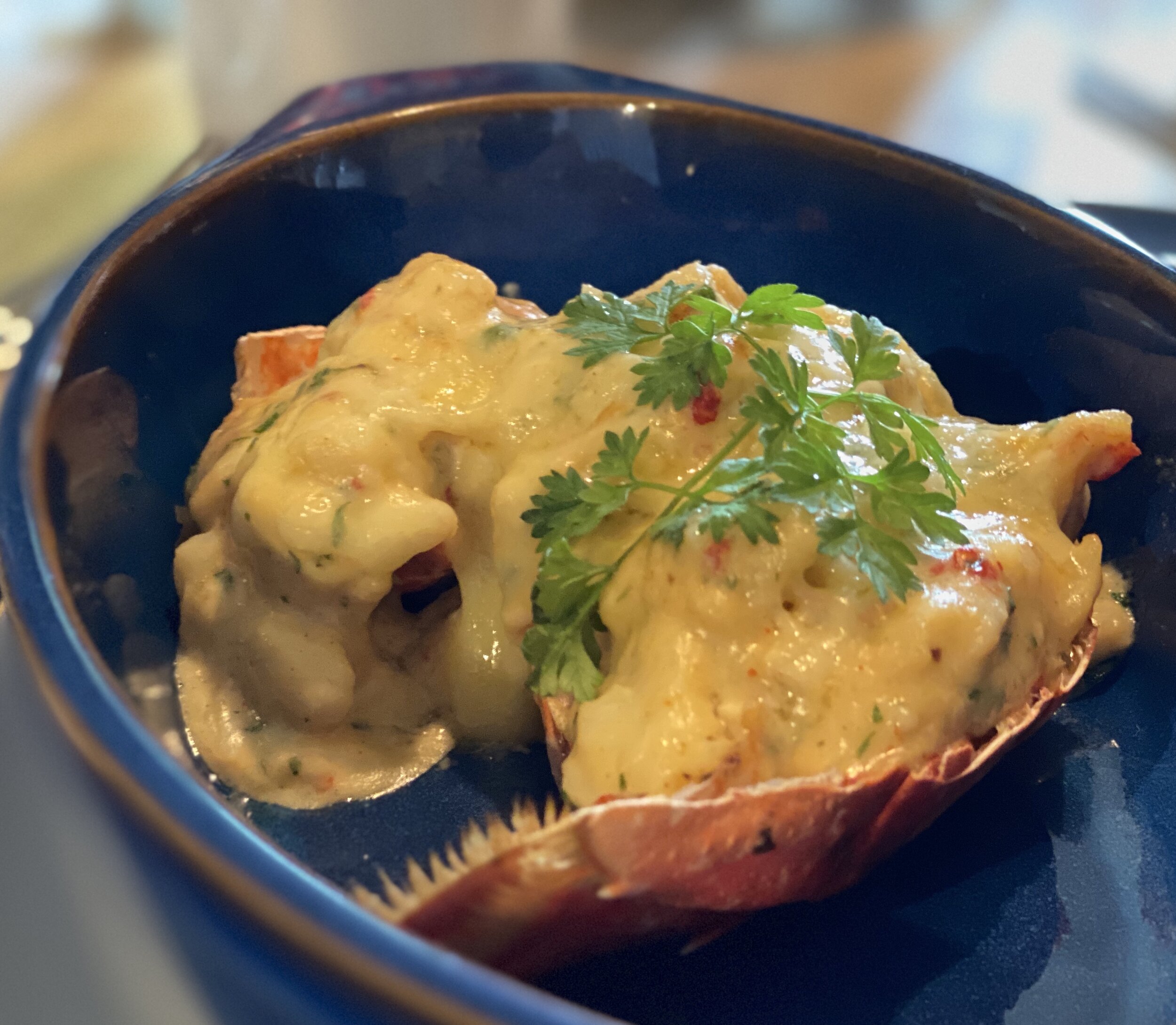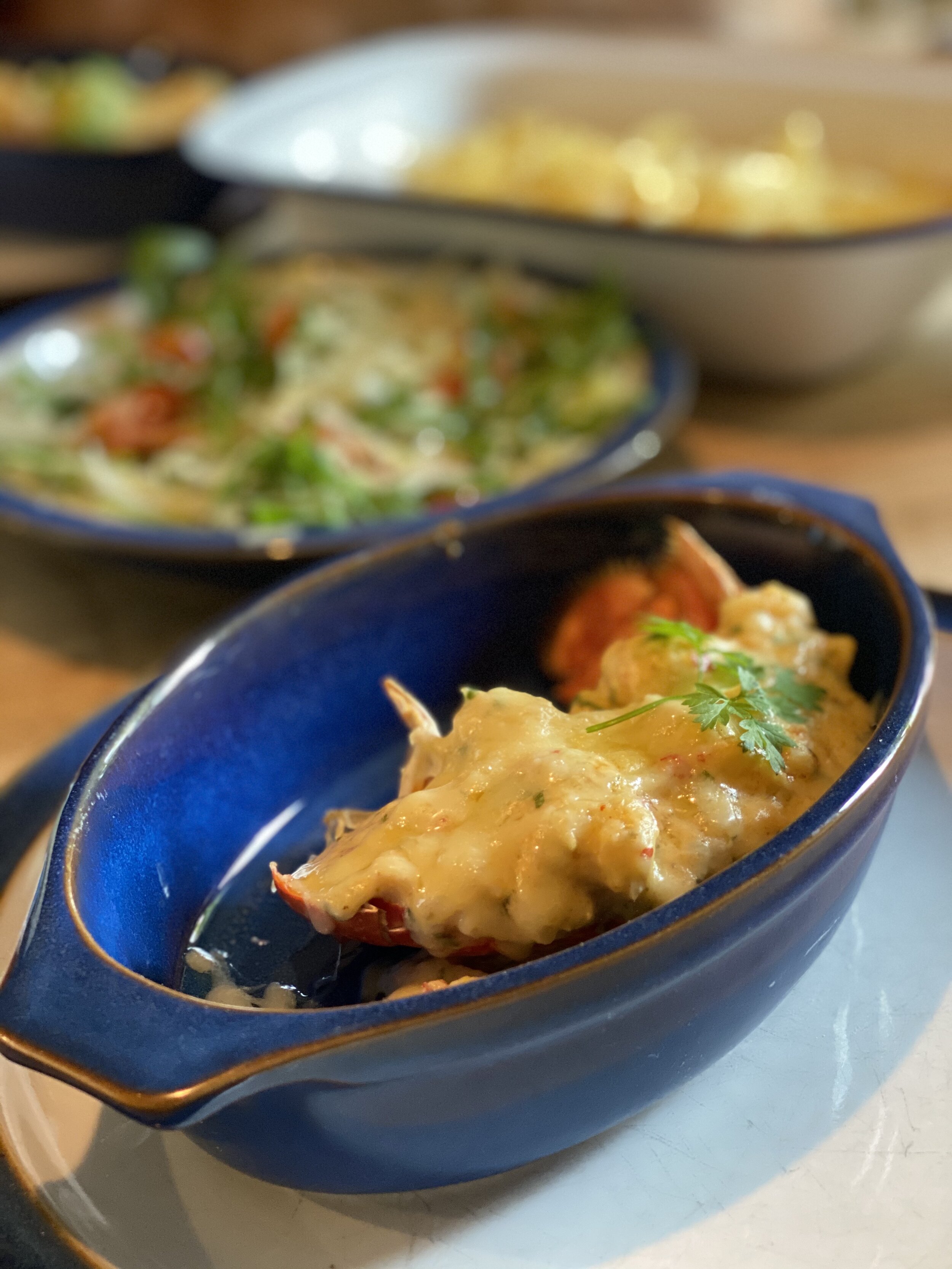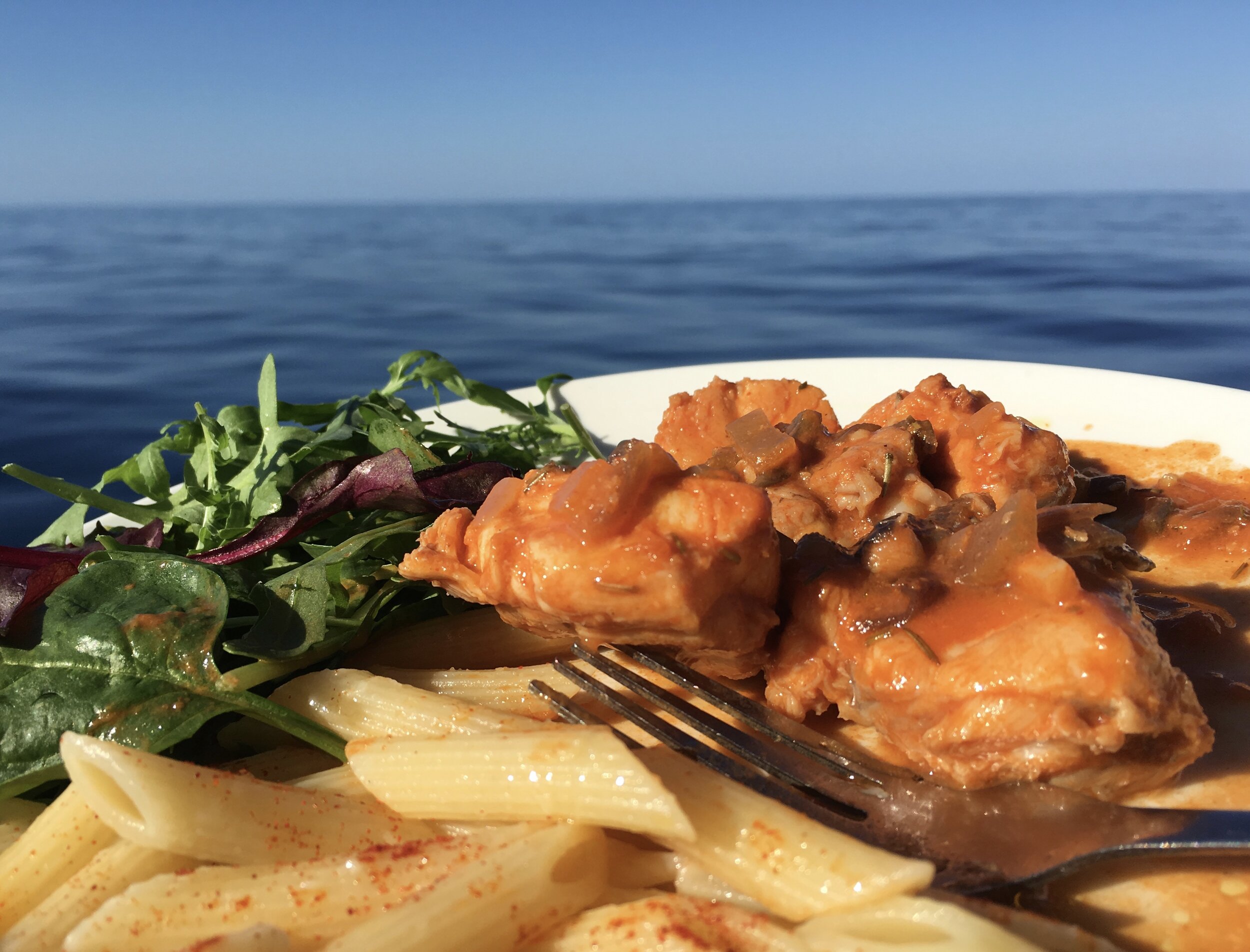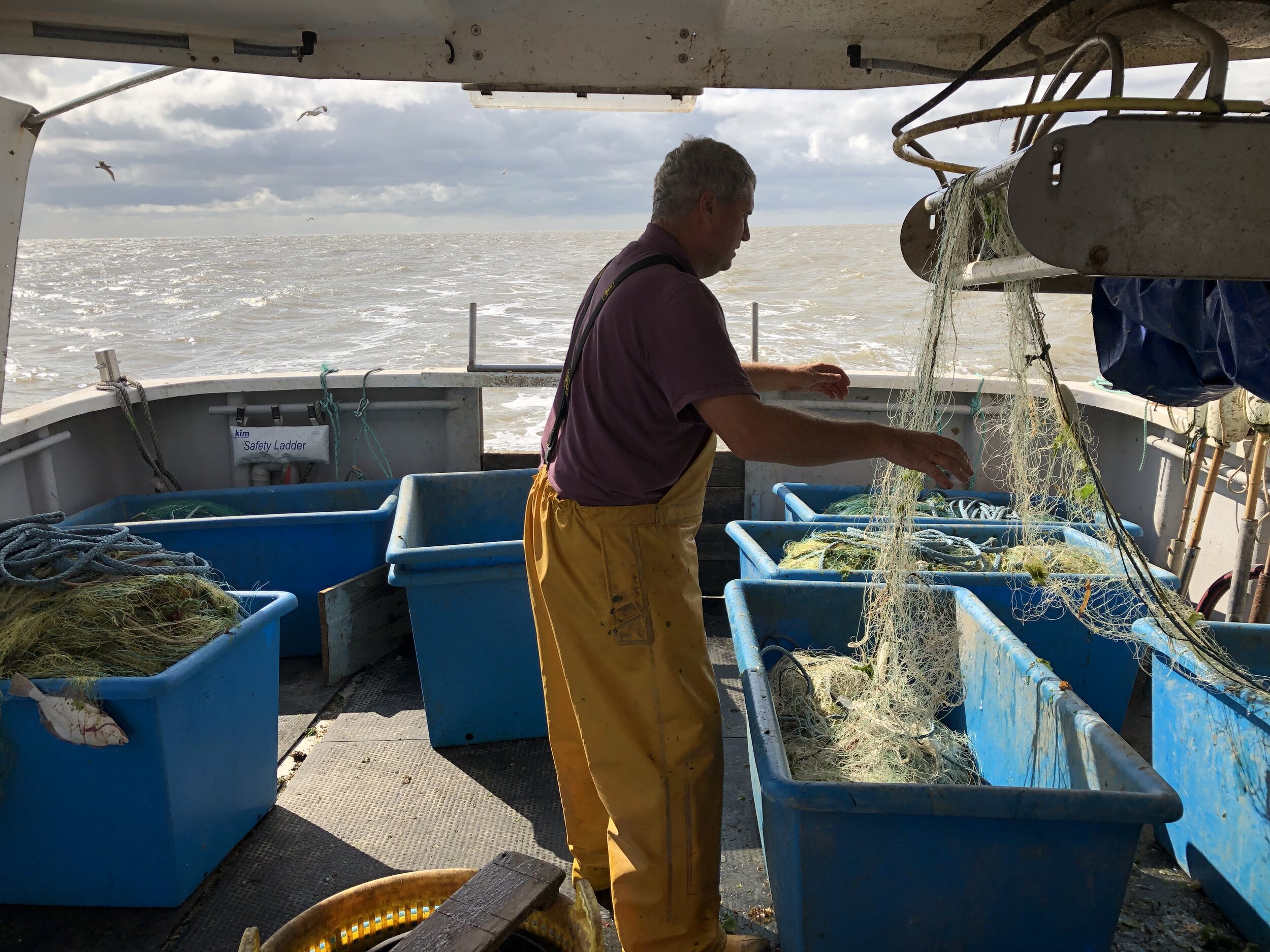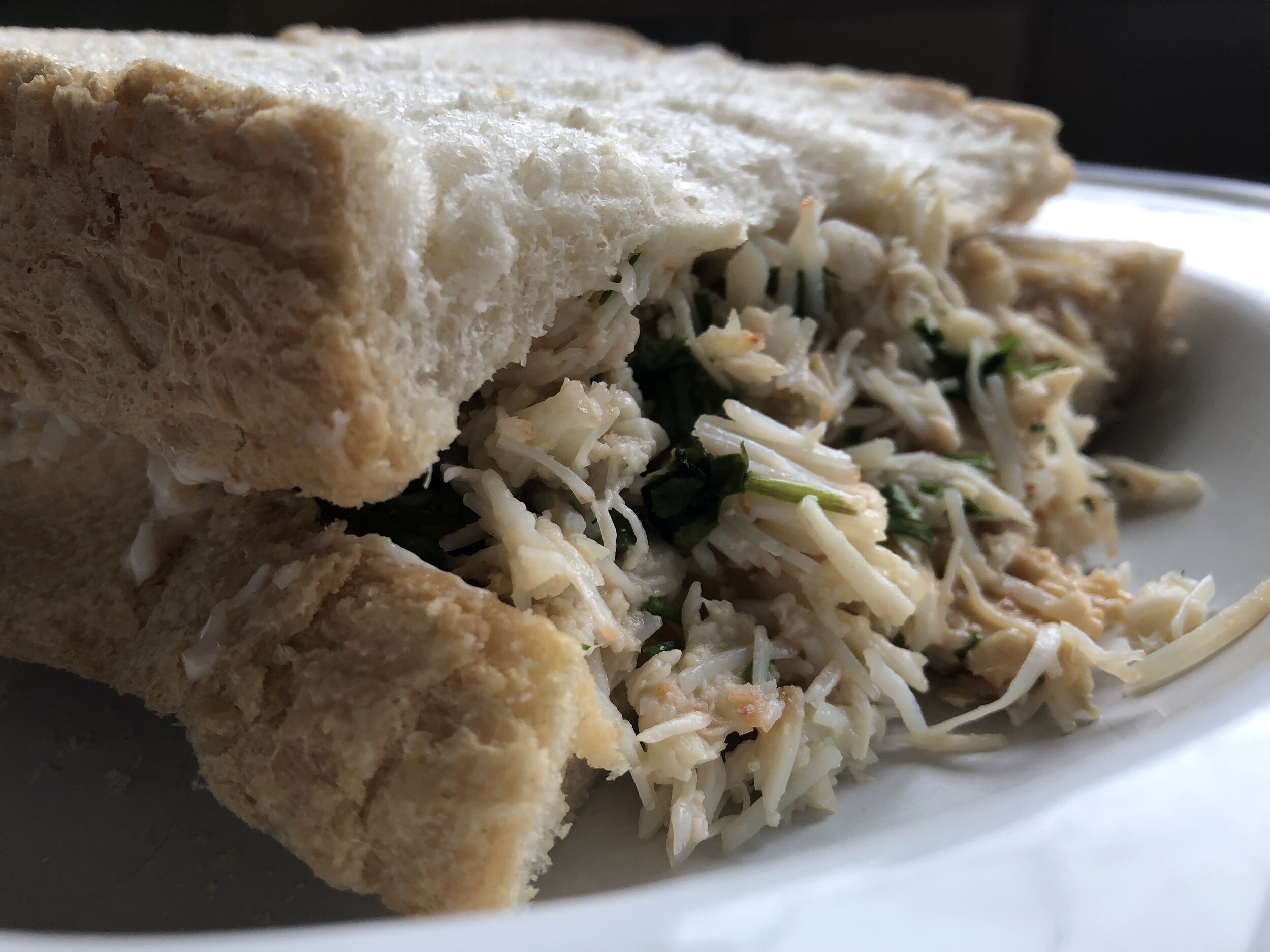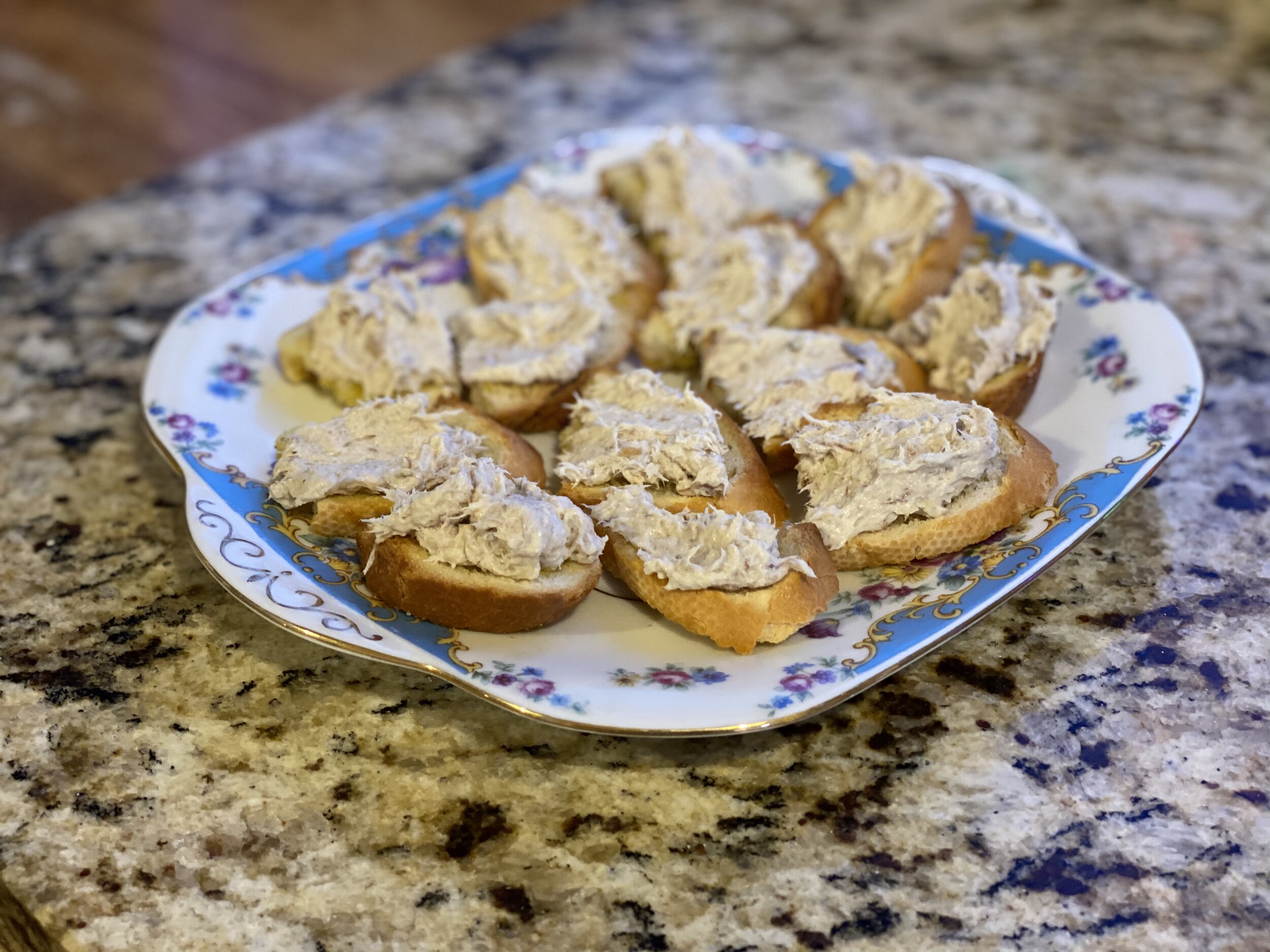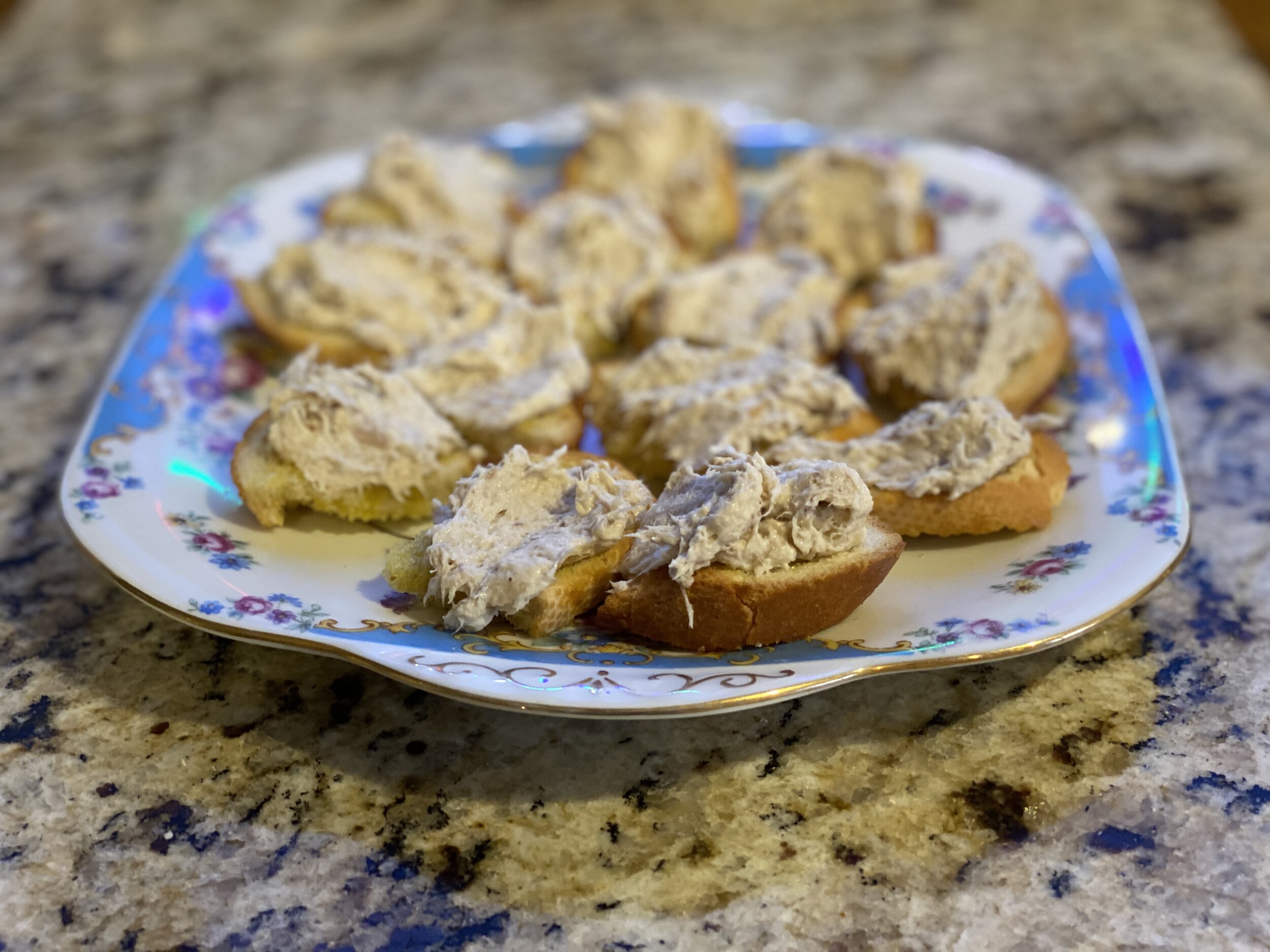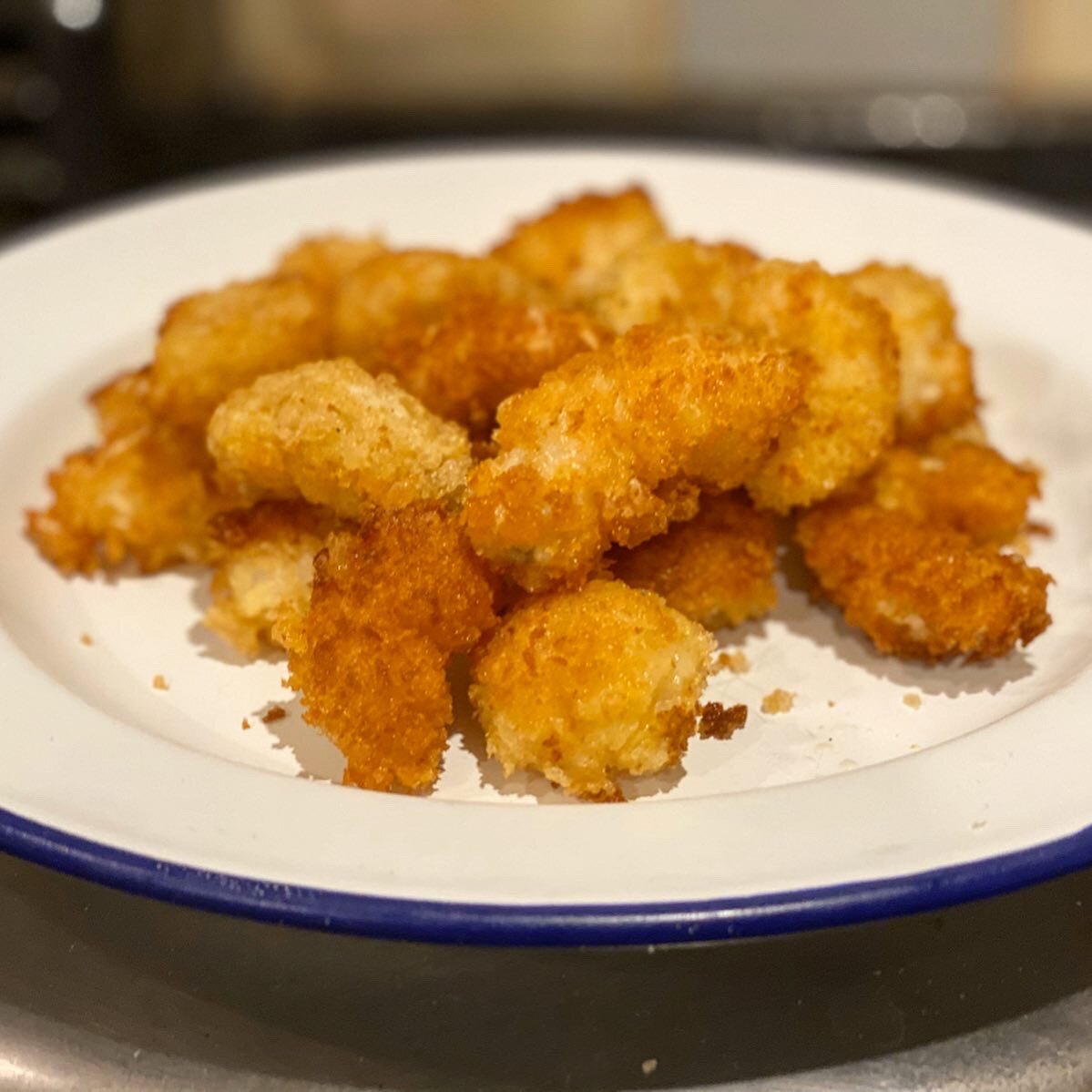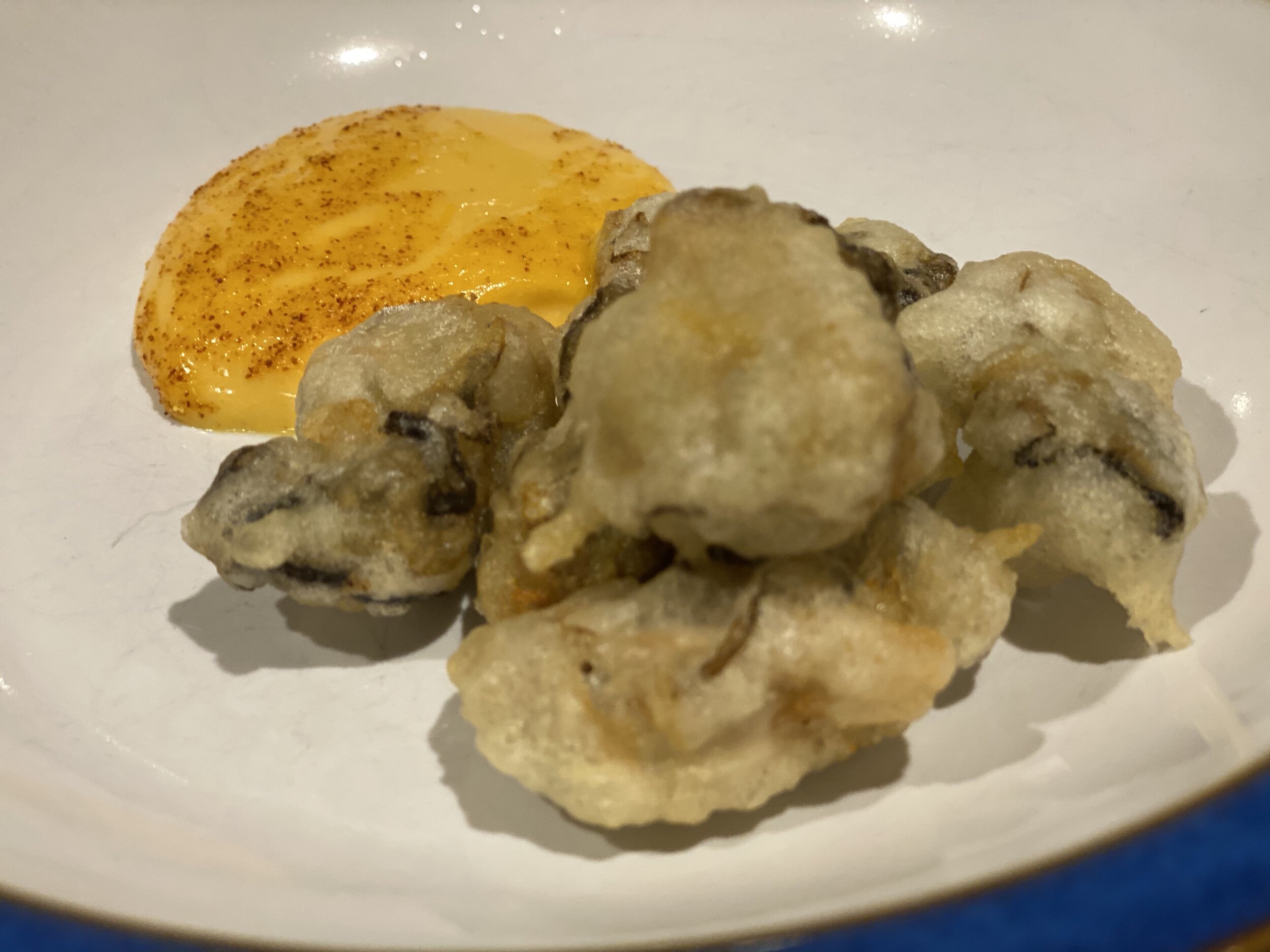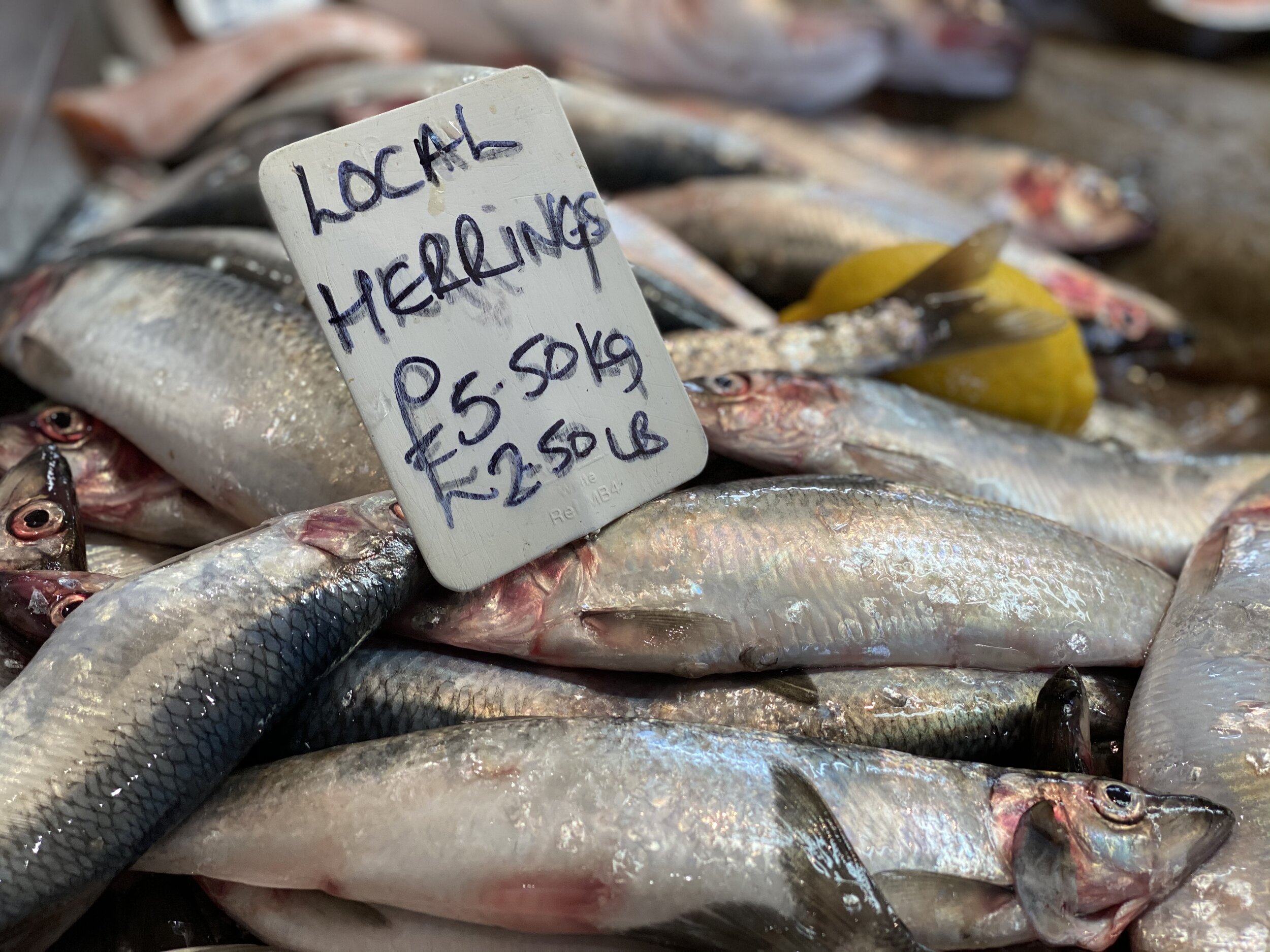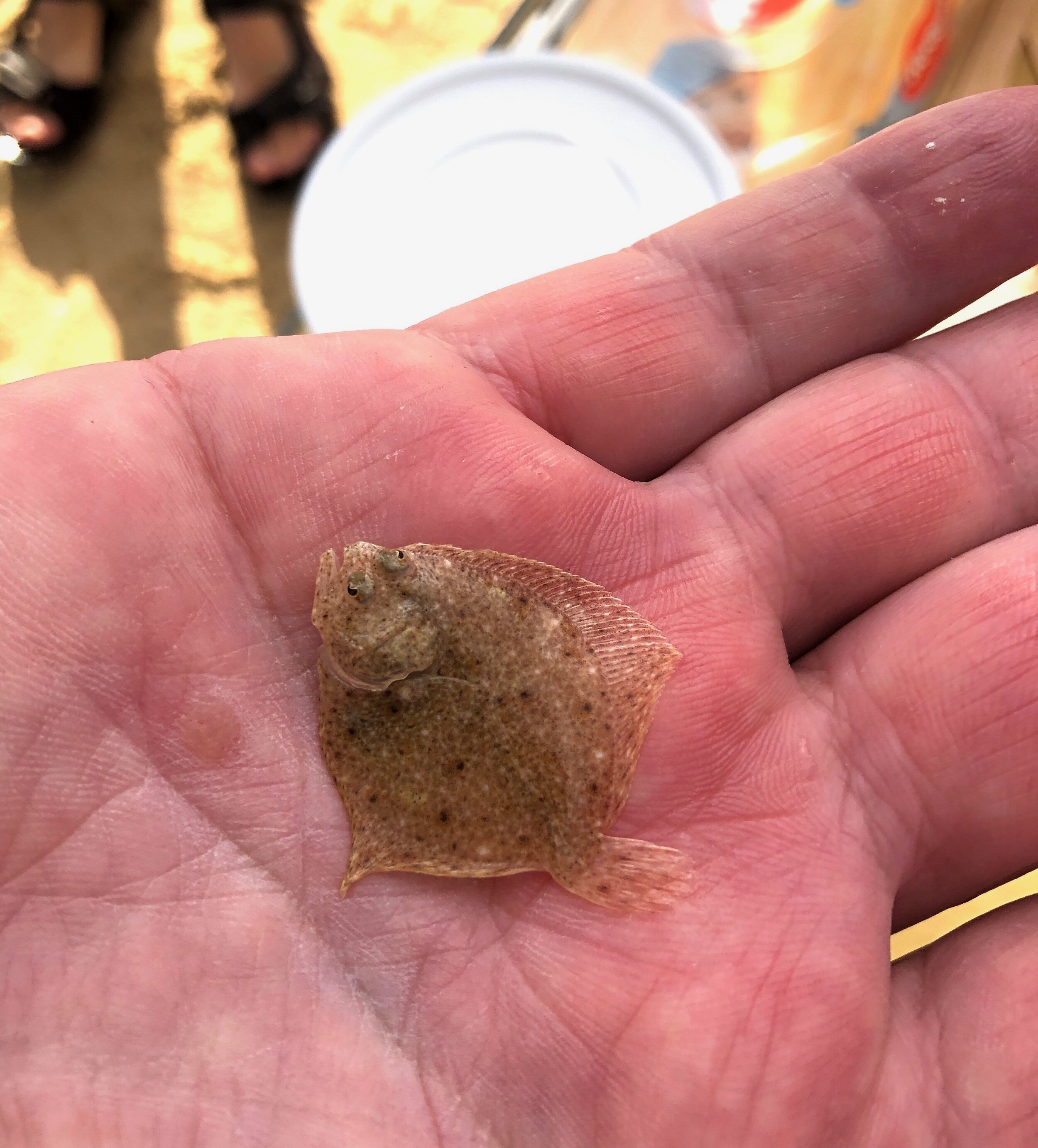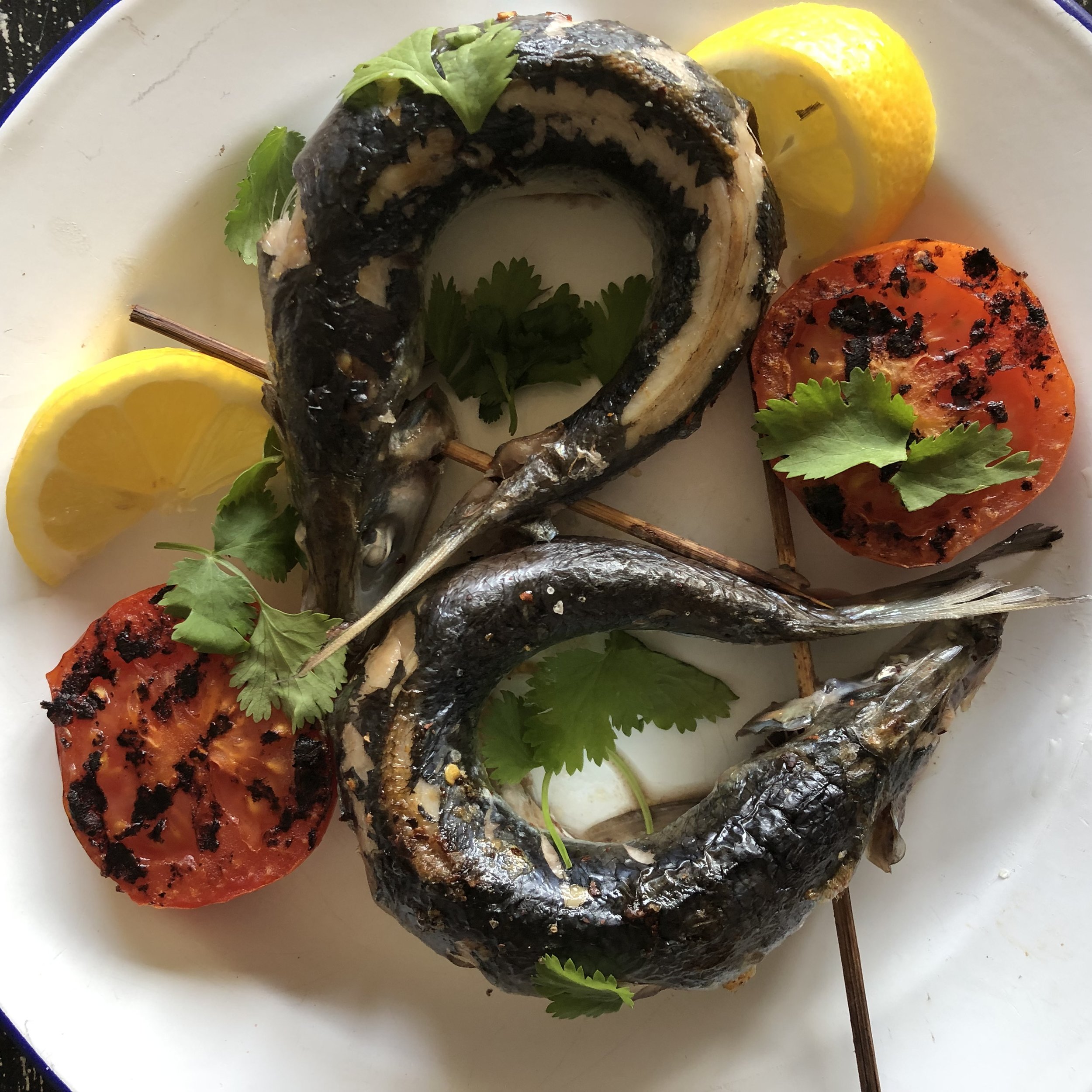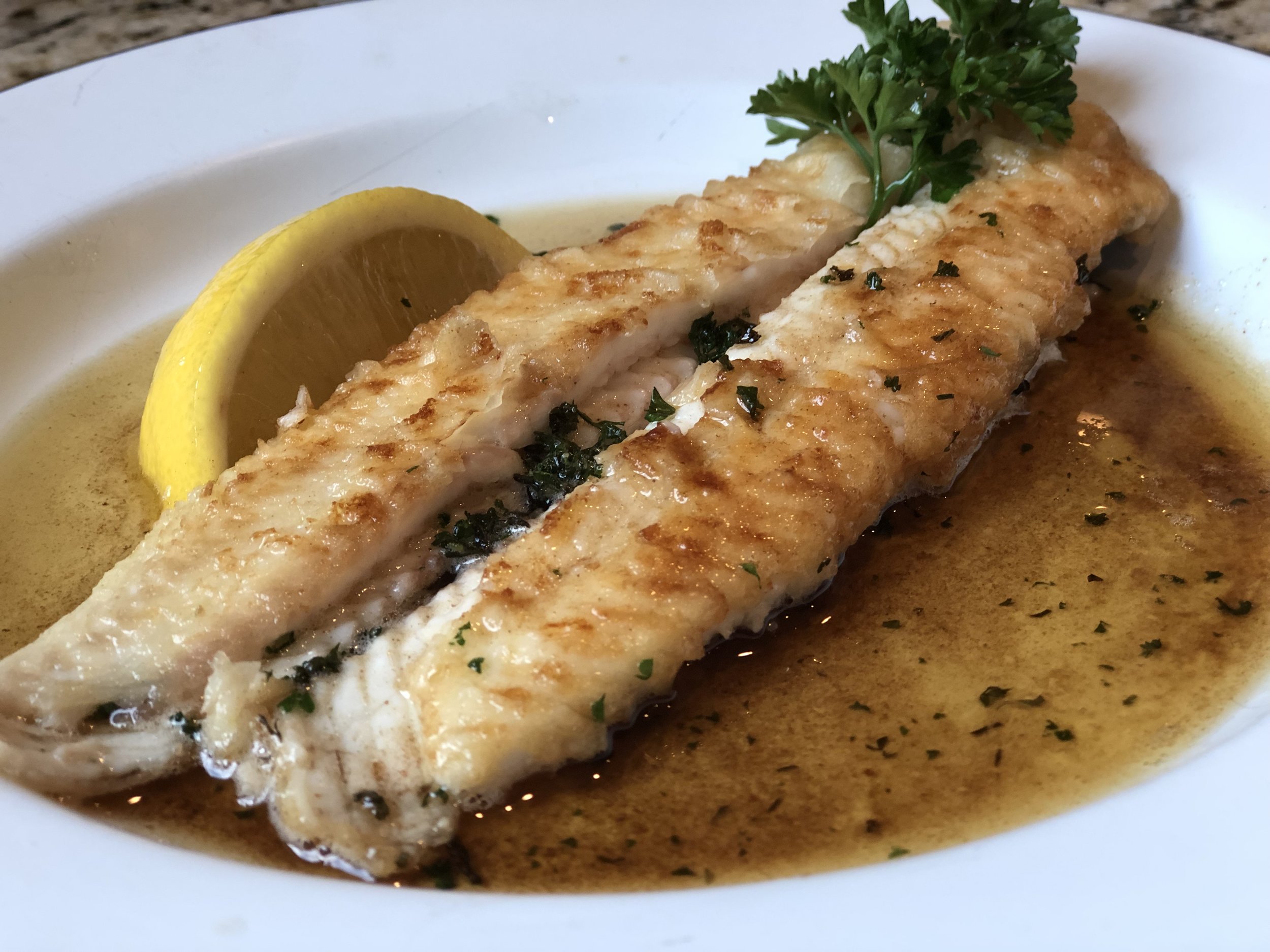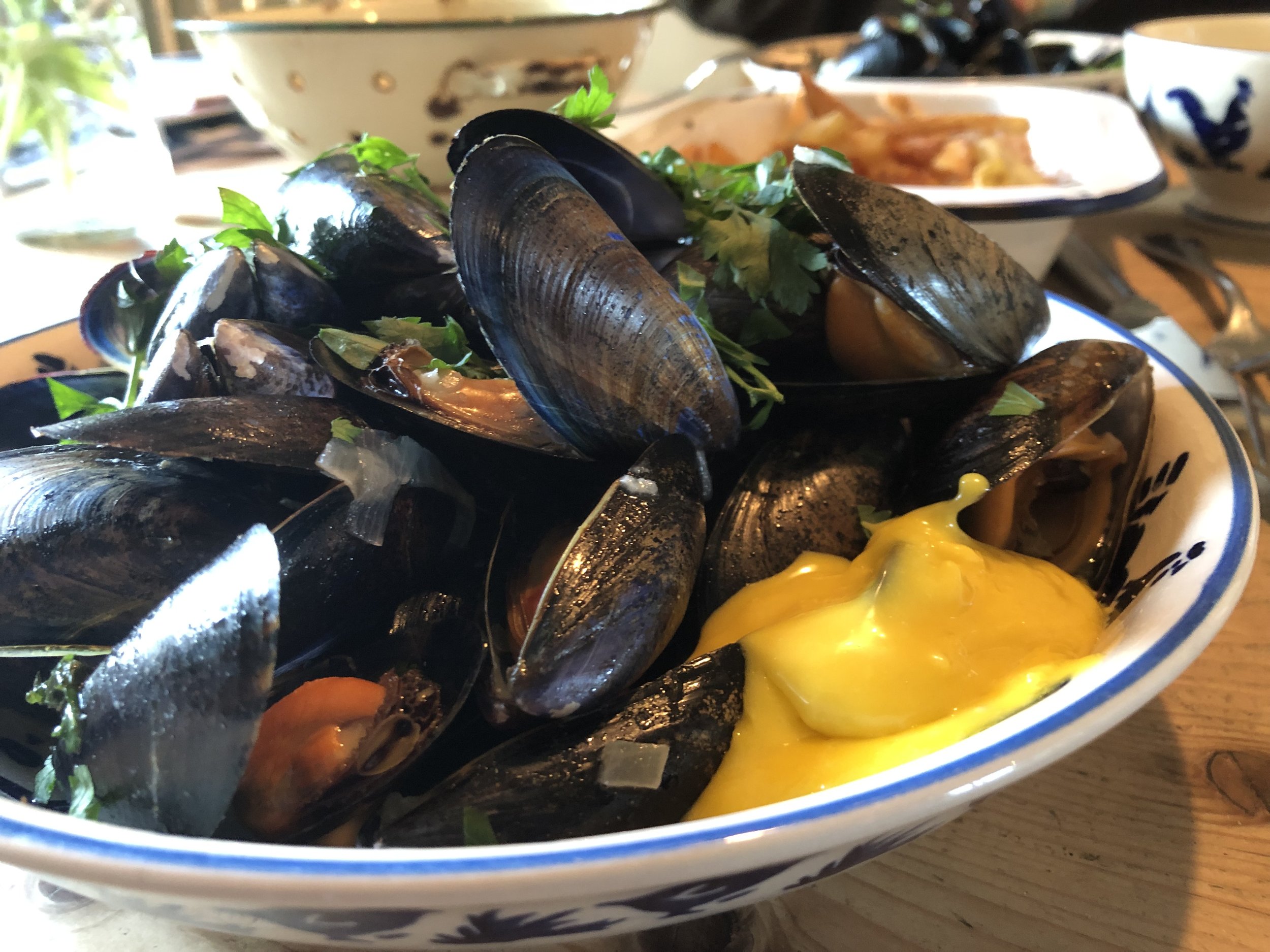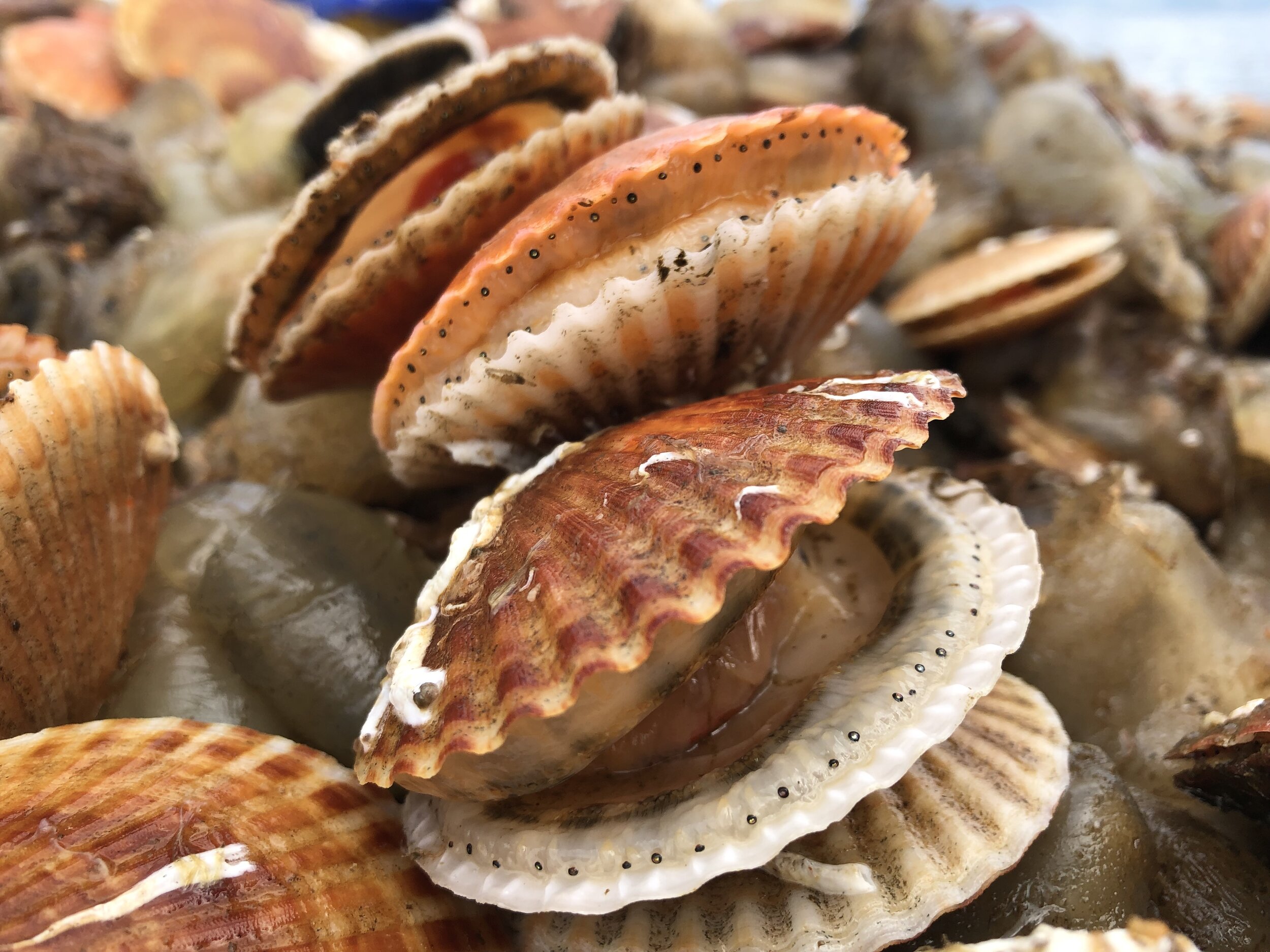An Update !
It’s been nearly a year since my last newsletter and that time has zipped by with the full force and speed of the run of an ebb Spring tide. In that time, ‘A Passion for Seafood’ has developed from merely a platform for UK seafood provenance and an exercise in developing new routes to market for fishermen (since April 1st 2020 into a multi-role business, supplying fresh seasonal fish and shellfish via both wholesale and retail, alongside the existing consultancy.
Originally, the business was focussed on writing and consultancy - storytelling if you like, making that vital connection between producer and consumer, often so astonishingly overlooked, by chefs, hospitality, media and government, with misinformation rife as to how ‘sustainable’ our seafood actually is.
Now here we are, approaching the ‘cod end’ of 2021 and finally, it looks like I might actually have some time to start writing again and supporting our rapidly evolving business with stories, information, recipes and broadcasts, which will reflect the seasonality, traceability and responsibility of the fabulous products we’re selling.
It’s been a very tiring and at times, trying time, over the last 20 months or so, but now the platform we have is even stronger and underpinned by a range of amazing products that I’m able to source from a myriad of dedicated UK boats and suppliers. From my first delivery of wild bass into London, in the back of my pick up, to a thriving wholesale business serving chefs and fishmongers along with our traditional Wet Fish Shop at Grange Farm near Woodbridge in Suffolk, we’ve come an awful long way, and I thank every one of you, fishermen, customers, chefs, suppliers and family and friends for your much appreciated, essential and ongoing support.
‘Net to Plate’ or ‘Shore to Shop are not just hashtags or sound bites, but reflect the essence of a philosophy for sourcing fish and shellfish of unsurpassed quality, with minimal environmental impact and the shortest possible route to market. Watch this space as we continue to develop our strategy and reach out to more consumers, by fundamentally supporting our fishermen and their communities and communicating the realities of the fishing industry via accuracy and integrity.
Look out too for more regular ‘Fish Tales’ again in the New Year!
Mike
Championing Net to Plate
I was delighted to have been interviewed by the lovely people at The Suffolk Pod Show, for a podcast in their series on Suffolk personalities, creatives and business people. The episode is about 30 mins long and I chatted to Susanna Hornby about my life in commercial fishing and seafood, what’s influenced and inspired me and of course my Passion for Seafood. LISTEN HERE
January Wild Bass
With the turn of the year, it seems a lifetime ago since we started selling our local Suffolk bass into London fishmongers. The wild bass season for commercial fishermen and anglers runs from April 1st to Jan 31st, meaning a closed season of 2 months, designed to coincide with the fish spawning.
With this in mind, we’re currently making the most of some significant catches of rod and line caught bass from our Southern Channel boats operating out of Weymouth Harbour; our own East Coast bass having mostly migrated back out to sea now, we’ve had to look a little further afield and there’s no doubt that these Channel fish are first class.
Caught very selectively, using lures, these voracious carnivores are caught when the tides are stronger as they feed on sandeels and mackerel over the banks and bars offshore of Portand Bill. The majority of the fish landed are between 1-2 kg currently, which are a fantastic eating size, but we’re also seeing specimens up to 3 and 4kg, which some of our London fishmongers are enjoying.
Fish after Christmas is generally poor, with boats slowly returning to sea after the break, but with the links we have direct to Skippers we can maximise our landings to suit our wholesale customers and also our now well-established retail venue at Grange Farm Shop, Hasketon where every Friday, you can come and purchase a selection of stiff-fresh, seasonal native fish and shellfish from around our coastline.
The bass are proving incredibly popular locally, either as whole fish to oven bake or fresh fillets, which pan-fry incredibly well or cook magnificently a la plancha. These just-landed bass (often sea to plate in under 24hrs), are of such exceptional quality they are also ideal for sashimi or ceviche and then of course there is the smoked!
We started cold smoking the bass a few weeks back with our partners Wightman Fishing in Lowestoft and we sell out of it at Grange Farm every week. It’s a very classy product and the feedback has been fantastic. A sort of turbo-charged smoked haddock, but way tastier and can be used in exactly the same way. Kedgeree, risottos, chowders or just simply poached in a court-bouillon and topped with a golden-yolked free range egg.
Stunning.
'Easy' Lobster Thermidor
I haven’t posted lately and there’s a reason for that, which will be duly explained in a separate missive. However, those of you who follow me on social media, will realise that my life has taken yet another fishy turn and I’m now reincarnated as a fish seller (I refuse to call myself a merchant). The Covid-19 crisis has precipitated a chain of events which has seen me come even more full circle and back to my intertidal roots, but as I say, that requires another chapter…..
Anyway my new guise involves in handling the most stunningly fresh and just-landed seasonal fish and shellfish from small day boats around our shores and one of the more ubiquitous species that pass thtough my chiller are native lobsters. I’ve waxed lyrical about lobs many times before of course, but as they’re coming into season everywhere right now, I thought it rather seasonally apt to share a simple, but classic, recipe that every seafood lover will cherish.
Little beats a freshly poached or grilled lobster with nothing added, save a homemade mayo or some tender asparagus, but just occasionally you fancy something just a little bit more adventurous and there’s nothing that screams ‘lobster’ in a rather decadent and epicurean fashion than a good old-fashioned ‘thermidor’.
Lobster Thermidor was orignally created by one of Auguste Escoffier’s chefs in Paris, in the late 1800’s, during which time a notorious play at a nearby theatre, was being performed. The title of the play was ‘Thermidor’ and so the dish was designed to accompany the play and enthuse diners, post performance.
Lobster thermidor of course, is often made with imported Canadian lobster to keep costs down and in fact langoustine, crawfish and even crab and spider crab compliment the dish very well. However, the perfect ingredient for me, naturally, is our wonderful native lobster and this version of the dish is not too overpowering, considering the nature of the sauce and the lobster’s delicate flavour.
A true Thermidor should involve brandy (cognac or armagnac), mustard and Gruyère cheese for the baked topping. This recipe uses white wine, instead of the cognac, still has the mustard and Gruyère, but slightly less cream and I’ve used fresh chervil in the mix in place of tarragon which is often also included.
A great way of making a little lobster go a long way and in my mind, as hearty and satiating a shellfish dish as you’ll find. You can also impress family and guests with something that looks and tastes very special.
Easy Lobster Thermidor - Serves 4
Ingredients
2 x 500g live lobsters (or cooked, if you don’t fancy the whole process)
250ml full fat milk
2 bay leaves
1 tsp English mustard
1 small onion chopped
1 tsp black peppercorns
100 ml dry white wine
1 tbsp creme fraiche
20g plain flour
1 heaped tbsp chopped fresh chervil
50 g Gruyère (grated)
Pinch cayenne
Method
Mix the milk, bay leaves, onion and peppercorns in a small pan. Bring to the boil, then set aside for 10 minutes to let the flavours infuse.
If cooking the lobsters from live, boil some salted water (fresh seawater if available) and put the lobsters in the freezer for 20 mins to induce dormancy. Alternatively, dispatch the lobsters by piercing the carapace behind the eyes with a suitable sharp instrument, which will kill them them instantaneously.
Introduce the lobsters to a rolling boil and then poach for approx 8 minutes - you’re not looking to overcook them ideally, as they will finish off in the sauce when baked..
When the cooked lobsters are cool enough to handle, extract the meat from the tails by splitting the lobster lengthways and removing the tail section. Remove the intestinal thread which runs down the dorsal side of the tail and discard. Reserve any roe (coral) and any tomalley (liver) from the head to use in the sauce.
Cut the tail meat into small bite sized pieces and extract the claw meat by cracking the shells and then do the same. Take the tail shell sections, wash and the bake under a moderate-high heat in the oven for 15 mins and put aside.
Take the seasoned milk and warm through, before melting the butter in a pan, till it foams and adding the flour to make your roux. Cook out the flour and then add the warm milk gradually, whisking until the sauce has a nice, silky-smooth consistency.
Soften the onions in the remaining butter in another pan and add the wine wine, increasing the heat so the mixture boils and reduces. Then stir in the sauce and whisk again over a low heat. Introduce the reserved coral and tomalley pressing out any lumps and whisk again. Now fold in the chopped chervil, mustard, half the grated Gruyère and combine with the creme fraiche with a touch of ground black pepper.
Place the shells in individual oven proof dishes or bowls and fold the chopped lobster meat into the sauce, coating liberally. Then spoon the mixture into the shells, top with the remaining cheese and sprinkle with a slight dusting of cayenne. Place the bowls under a high, preheated grill for 6-8 mins or until the cheese topping has browned and the sauce is bubbling.
Serve immediately with a simple green salad, frites or crusty French bread and a glass or two of something like a Muscadet or a White Burgundy.
Lobster heaven!
Pulled skate and paprika potato cakes.
Well, Thornback ray to be absolutely correct. This species often gets unfairly thrown into the ‘must avoid’ mix by bodies such as the Marine Conservation Society (MCS), who generally do a very good job of advising consumers on which species of fish and shellfish to eat, using their Good Fish Guide warning system, but fundamentally fail to take one aspect of fishery abundance into account and that’s what I call ‘Local Sustainability’ .
The word sustainability itself, I find rather nebulous and an easy cop-out when describing the state of fish stocks, the local economy or even peoples’ businesses and livelihoods. It of course, has to embrace the three key characteristics that define it, namely. Environment (the fish), Economic (the businesses) and Social (the communities). If the fishery, method, port, market etc can tick all three, then the management is deemed responsible and beneficial.
The trouble is that for skates and rays, currently most commercially caught species, Blonde, Spotted, Small-eyed, Starry and Undulate are rated a 4 (think before you buy) or 5 (avoid altogether) by MCS, which of course in the case of late maturing and less abundant species, like the Starry ray, is a perfectly reasonable suggestion and certainly one that I would endorse. However, your average shopper, once the skin has been pulled off the wings, couldn’t possibly identify the species and so avoidance anyway becomes the rule.
Now I have a problem with that, because, here on the East coast, we have a super abundance of Thornbacks, (or Roker, as we call it - Raja clavata to be precise). They have been described by the fishermen recently as ‘wall to wall’ and are supremely abundant, from the Thames to the Wash. So ubiquitous so, that you can’t actually avoid catching them, by whatever method - otter trawl, beam trawl, fixed gill net, drift net or longline. Such has been the problem, that the fishermen often have to steam (travel) further than normal to avoid them.
Compounding the issues further, is the fact that at market, the price the fishermen receive for the roker - especially if lots have been landed, can be counted in pence per kg rather than pounds. Because consumers aren’t encouraged to eat skate either - (supermarkets won’t generally stock it apart from Morrison’s) then the supply outstrips demand and up until the virus crisis any surplus was exported to nations who know better.
So, I call this a problem with recognising which species can be locally or seasonally sourced, because they are in fact fully ‘sustainable’ for that geographical region and for that particular population - remember that our mixed fisheries in the UK are made up of populations that sometimes can be remarkably different in size and abundance e.g bass.
Once the unwitting shopper has consulted their Good Fish Guide and made an informed decision not to buy skate, because of its ‘general’ unsuitability, there’s only one person who will lose out - yes of course, the fishermen, who having toiled their hardest, often in appalling conditions to land their beautiful and delicious Thornbacks, then can’t sell them locally as everyone assumes they're an endangered species.
I hope I’ve explained that ok, but its a fact and doesn’t just apply to skates and rays; there are many other seasonally-abundant species out there - catch opportunities which are being consistently denied to fishermen through inadequate knowledge or incomplete science and poor datasets.
However, having imparted that bit of ‘wisdom’ to you, here’s a very simple way of enjoying a fine wing of Thornback ray without having to feel guilty or concerned for the environment. Cooked simply in brown butter with capers or with some cockles or brown shrimps is my preferred way, but this recipe is great for children too and introduces them to a different species without the fuss of having to eat straight off the bone.
Pulled Skate and Paprika Potato Cakes (Serves 4)
Ingredients
1 skinned wing Thornback ray (about 500g) (or another seasonally abundant ray species)
2 bay leaves
A few black peppercorns
500g boiled floury potatoes for mashing
200g salted butter
2 tbsp creme fraiche
1 tbsp smoked paprika
2 handfuls grated mature cheddar
1 tsp English mustard
4 spring onions - finely chopped
Small bunch chives - finely chopped
1 free range egg - beaten
Sea salt
Freshly ground black pepper - to taste
Method
First poach the wing in a suitable pan in salted water, (or a court-bouillon ) with the black peppercorns and the bayleaves for about 8 mins. Ladle out and drain.
Fork the ray meat away form the wing frame (pulled) and set aside.
Mash the potatoes incorporating the mustard, half the butter and creme fraiche and a little salt and pepper. Put in mixing bowl and fork in the pulled skate, adding the cheddar, paprika, chives and spring onions. Work everything together and add as much of the egg as is needed to bind, without making the mixture too wet.
Form the mixture into cakes (about 1 tbsp each) and flatten slightly ready for frying.
Melt the remaining butter in a heavy frying pan and introduce the cakes when it starts to foam. Fry them turning once or twice until the sides are crispy and golden brown.
Repeat for all the cakes (makes about 8) and serve with a green salad.
Reflections of a Seafood Lover
I’m writing this, not out of pure nostalgia, but because in the current climate, with as desperate a situation unfolding as any of us can really remember, I think it does us good to reflect on what we would consider to be ‘normal’ life and try and focus on some of the things that make our lives bearable, manageable and moreover, special when it comes to food.
The picture above, of a dish of Monkfish Provençal cooked and served up to me by First Mate Matt Price, on board the hake netter ‘Ajax’, 40 miles West of the Scillies, was undoubtedly one of my all time seafood highlights. Eating fresh fish, only minutes out the water and cooked by the guy who landed it, in that wonderful marine environment.
Now, I’m no philosopher, but I do fervently believe in the deep-seated food memories that shape our being and our daily existence, so much so, that a mere fragrance, colour, sound or melody can evoke profound stirrings in our psyche, which stimulate our taste buds and thence our desire to create something special.
For me I always feel justly at home at a fishing harbour, on a quayside, a vessel, a landing stage, pontoon, beach, sea wall, market hall, fisherman’s hut, or by a fishmonger’s slab………the list just goes on. The sights, smells and sounds of the sea and that coastal scene that I find so naturally evocative, can often bring me close to tears, as I recall with overwhelming fondness, the times I have spent at sea, either fishing, in the company of fishermen or just cooking freshly caught and landed seafood.
Whether it’s the long call of a herring gull, the idling of trawlers’ diesel engines along the quayside, the shout of the auctioneer in the market or the clattering of a fish box-laden forklift along the harbour wall, it stirs me deeply. These memories and images that spring to mind keep me going when things are fraught.
Sunrise or sunset over the horizon, the emerging hues and colours that herald a new dawn and nod to a receding day. A dark moonless sea, bursting with green phosphorescence with each wash of the bow and the sparkling emeralds that drip from the gear as it’s hauled. The seasons and their omnipresent and predictable ways, their signs, signals and meanings. The catch itself, resplendent in the whole spectrum of colours that identify the different species of fish and shellfish that represent our amazing mixed fisheries and the joy on crews’ faces as their trip is made with each iced box stowed below.
The weather, let’s not forget that, which can sully even the hardiest of souls, salt-lashed in a bitter gale as they continue to work against the mountainous, rolling backdrop of the ocean and by contrast, the sun sparkle; shimmering and glittering, jewel-like, on a glassy flat-calm sea - the morning sun on your back as you steam to the first dahn. Even the smell of rotting bait, mingled with diesel fumes from a bubbling exhaust has its place in my sensory bank.
Then there’s the wildlife at sea, sightings and experiences that though seldom witnessed by those not accustomed to life afloat, never fail to stir the soul. Dolphins, porpoises, sharks, the lazily lolling sunfish, seabirds - gannets, fulmars, skuas and a whole host of other gull species, clamouring and vying for scraps (or more) in an aerial frenzy, aft of the the gutting knife.
These memories and thoughts are what keep me doing what I do. They inspire me to do more; to learn, to understand, to get involved and to promote what has, I realise now 55 years later on, always been my true passion.
We’re trying to navigate uncharted waters currently and it’s certainly not plain sailing. However, we have fantastic resources in our midst. We have the most diverse, abundant and responsibly-fished waters in the Northern Hemisphere and of course to harvest them we have our fishermen - the last of the wild hunters, risking their lives daily to feed us and their families, on a timeless quest. Now, perhaps more than ever they need our support. Our food has become so commoditised and we, so detached, from the realities of production, that our seafood eating culture has erred and strayed from the path we once knew. However in times like these, our seas will once again provide for us.
Support our fishermen and their amazing industry, be thankful for their toil and delight in the fruits of their labours and embrace, once again, our Great British Seafood.
Mike
Brown Crab, China and Jamie Oliver
It couldn’t have come at a better time really, because in the immortal but slightly erroneous words of the Apollo 13 mission. ‘Houston we have a problem’ - a big problem and it involves the story of one of our most abundant and traditional seafood species - the brown crab (Cancer pagurus).
Last week saw the Channel 4 re-run of Series 6 Jamie Oliver’s Jamie & Jimmy’s Friday Night Feast, where in episode 1 accompanied by his erstwhile partner in food heroics, Jimmy Doherty, Jamie sets out to discover why the UK consumer eats so little brown crab compared to other neighbouring nations who eat it by the lorry load.
It’s a very simple question to answer really, but a much harder one to address when as a country we consume so very little seafood anyway and even then 70% of what we do eat is imported. Yes, it’s still the ‘infamous five’ I’m afraid. Tuna, salmon, cod , haddock and the tedious, never ending, conveyor belt of farmed Asian prawns that adorn just about every supermarket cold shelf in the kingdom.
The paradox is (and I’ll say it once again), that we do have the best quality fish and shellfish in our waters of any country in the Northern Hemisphere and yet we export 80% of what we catch and farm. Brown crab, as Jamie Oliver found out during our seaside exploration on the South Coast, is mostly exported and more recently, mainly to China, in a colossal market worth approximately £50m/year.
Until now…..
Just before Christmas, Chinese government trade officials announced, quite glibly, that they would no longer be accepting shipments of live and processed brown crab from the UK until further notice and that’s before Coronavirus reared its ugly head. Now, I’m not going to delve into the political complexities surrounding this announcement, but what I can tell you is that we land around 30,000 tonnes of these wonderful crustaceans into UK ports every year, and relatively very little makes its way onto our tables. Half of that figure has been attributed to China, with other export markets such as France, Spain, Portugal etc accounting for most of the rest.
So notwithstanding the fact that Messrs Oliver & Doherty have been doing a sterling job reinvigourating our passion for the white and brown meat, there could soon be an awful lot of crab suddenly looking for a home, once the spring landings start from Bridlington to Brixham.
Now call me old fashioned, but when the fishermen have seen prices leap to around £4/kg on the quayside for their product in recent years, a drop to around £1.50/kg or less, seems realistic now and with massive investment in the crab catching sector on the back of the exports to China, a lot of fishermen are already mightily concerned about this year and the prospects for continued trade.
When I’m giving talks on seafood consumption and sustainability, I always say that any export market is never guaranteed and a fallback position is essential to protect incomes and livelihoods. That fallback position has to be the domestic market, but of course it’s incredibly difficult to be reactive, when you have a poor record on seafood consumption and a culture and retail sector that lacks understanding and passion for the product.
However, I’m eternally optimistic and a little knowledge does indeed go a long way. Jamie and Jimmy say it very well in their programme and people shouldn’t see it as just a jolly on the pier, but a message with integrity and reason. When we recorded the programme the Chinese crab market was in full swing, it’s now ebbed to a trickle and a full stop.
Have a look at the episode - you can find it here and at 20-26 minutes in on More4 (you might have to sign in). See what you think and I can guarantee that your mouth will be watering by the end……
The Ultimate Crab Sandwich
Everyone, yes everyone, should be made to try a good crab sandwich once in their life. My mother was obsessed with them and had a dream of retiring to Cornwall to sell them in a little kiosk on Looe harbour quay. I don’t honestly think she’d have made a lot of money, as such was her ardour for their flavour, she’d have just ended up making them for herself.
Ingredients (Serves 2)
250 g fresh picked white brown crab meat
100g fresh picked brown brown crab meat
2 tbsp of fresh, homemade mayonnaise
Several thick doorstep slices of fresh white bloomer loaf, or a split crusty baguette.
Cornish dairy butter
Half a lemon
Freshly ground black and white pepper.
Method
Mix the brown meat in with the mayonnaise, a squeeze of lemon and fold to a smooth consistency. Butter the bread liberally and apply the mayo/brown meat mix. Heap the flaked white meat on to the prepared slices, firm down a little and again squeeze a little lemon over. Dust with a little white pepper and grind over some black pepper too, to your taste.
Close the sandwiches off and firm again before slicing and serving. You could of course add fresh herbs parsley, coriander or chervil to the mix (the latter being particularly suited to crab), but actually there’s nothing like having it unadulterated. Enjoy with a cold beer. Beer and crab go phenomenally well together.
Premium Pollack
With pressure on many of the gadoid (cod-type) stocks around the country and heightened awareness to source responsibly and sustainably, it’s really no surprise that fishmongers, merchants and their customers look for suitable white-fish alternatives that can be sourced seasonally and represent good value for consumers.
Although I’m a huge fan of the super-abundant whiting, in southern and western waters, Pollack abound, and provide a very useful catch opportunity for the inshore fleets from Weymouth to Wales. Streamlined, graceful with a green/gold lustre and bulging oversized cod-eyes for detecting prey amongst the kelp beds, these beautiful fish are now, much loved by chefs and home cooks alike. I find they lack the intensity of cod or haddock and perhaps the sweetness of whiting or pouting, but fresh out of the water they can be absolutely delicious and even smoke quite well too, but their shelf-life is perhaps not as enduring as their historically used cousins.
I’ve caught them in Mounts Bay just off Penzance using two methods - netting where ‘short-soak’ nets are set for a few hours and line caught, using a board which dives an artificial sandeel lure amongst the ravenous schools hooking them individually, to ensure the fish are absolutely in top condition for sale.
Down in Cornwall in the late winter and early spring months the pollack feed inshore in the colder winter water, on sandeels , sprats, sardines, small mackerel , crabs and prawns and in fact anything that fits in their rather gargantuan gape.
They are more than suited to coating in batter and aside from frying the whole fillet, I like to skin them and goujon them into bite size pieces and serve as you would the whiting in my tempura recipe, albeit with a beer-based batter in this case. Very moreish and a great alternative if you fancy a change. However you won’t find these beauties in your local supermarket as they're not generally a species that lends itself to fresh or chilled counter sales. Don’t be fooled though, you will indeed see Pollock on sale, mainly in frozen form. This is generally imported Alaskan or Southern Hemisphere product and although an important commercial species, won’t help you support the UK inshore fillets to whom the Pollack is a seasonal and welcome catch opportunity.
Pollack Goujons with a Tomato and Fennel Salsa
Ingredients (Serves 4)
Two fresh, skinned, Cornish pollack fillets.
150g plain flour
150ml light beer (bitter/lager)
Sea salt
Black pepper
Lemon wedges.
Sunflower or rapeseed oil for frying
For the Salsa
1 fennel bulb, sliced
4 large tomatoes
Splash white wine vinegar
50ml good olive oil
Juice of 1/2 lemon
1 tsp caster sugar
Sea salt
Black pepper
Method
Cut the pollack fillets into bite-size goujons and dredge with the seasoned flour and shake off any excess.. Put aside. Heat the oil to 180 degrees in a suitable frying pan.
Make the batter by sifting the flour into a bowl and whisking in the beer to a smooth, but not runny, consistency. Put aside.
Combine the salsa ingredients and drizzle with the olive oil and lemon juice and toss. Place the goons in the batter coating liberally and introduce individually to the hot oil, taking care to keep them from stocking to the pan. Fry them for 2 mins on either side until, the batter is crisp and golden and the goujons are stiff enough to be stacked together.
Remove from the pan and drain on kitchen roll. Serve immediately the salsa and some homemade mayonnaise or tartare sauce (see Whiting Tempura).
Fishers Gin-Cured Herring with Orange, Cucumber and Fennel
Unfortunately the herring have moved on. Having spawned inshore in the autumn months, the vast schools of now ‘spent’ ‘Silver Darts’ as we affectionately know them have now moved offshore again to feast on plankton and build themselves up once more. Having released or ‘shot’ their roes in a fertile miasma of spawn, these ubiquitous fish have lost a lot of condition and fat content. Of course that by no means renders them inedible and they are still ideal, in my opinion, for pickling or curing, rather than just salting down for lobster bait, which our local guys do here at this time of year.
However, if you don’t have access to fresh fish, then frozen is perfectly acceptable and this very simple recipe uses either and brings to the fore the flavour of the fish and also of the gin.
This is a also a recipe that I’ve developed for Fishers, our new, local, artisan gin distillery on the Suffolk Heritage Coast at Aldeburgh. I’m proud to be working with them to connect the local fishing industry and their accompanying catch to their product and ethos and it’s become a very exciting project.
So curing the herring with your favourite tipple can be highly rewarding and with Fishers even more so, as it is a true ‘coastal’ gin, harnessing the provenance of the seashore and marsh in the various locally-foraged botanicals and exploding onto the palate with combinations of flavours, that set it apart from any other.
So too with the herring, as the unique savouriness of Fishers Gin is instantly identifiable in this dish and makes a perfect pairing for their signature G&T.
Fishers Gin-Cured Herring with Orange, Cucumber and Fennel
Ingredients (Serves four)
Four fresh or frozen herring fillets
2 tbsp caster sugar
4 juniper berries
2 tbsp sea salt
Orange zest
Squeeze of fresh orange juice
150ml Fishers Gin
Fresh ground black pepper
For the fennel and cucumber salsa.
Half a cucumber thinly sliced.
A fennel bulb, thinly sliced.
150 ml olive oil
Squeeze of orange juice
Salt and pepper
Method
Slice the herring fillets into ceviche-like slivers and lay out on a flat tray.
Combine the salt, caster sugar, juniper berries and orange zest and blitz in a food processor for a couple of minutes. Sprinkle the cure over the herring evenly ensuring all the fish is coated, then drizzle over the gin and squeeze over the juice straight from the orange.
Next cover tightly with cling film and refrigerate for 6 hours.
Remove the cling film and wash off the cure, dry on kitchen roll, then cling film and refrigerate again for another hour.
For the salad, combine the ingredients and toss lightly together in a bowl.
Spoon the salad onto individual plates or into ramekins and arrange the cured herring on top, garnish with black pepper, sea salt and another squeeze of orange if necessary. Serve immediately.
The Ultimate Smoked Mackerel Pâté
To finish off the Festive Trio of canapé deliciousness, here’s an old stalwart that never fails to impress, especially of a Christmas Morn. Now, I love smoked salmon, don’t get me wrong, and not a Yuletide passes without it. However, if you’re looking for something smokey that doesn’t cost the earth to feed everyone and still has exceptional quality (there’s a lot of smoked salmon out there I’d avoid) then a well-constructed smoked mackerel pâté atop some homemade crostini or blinis will accompany your festive fizz.
Recently I was lucky enough to acquire some locally-smoked mackerel, which is some of the finest I’ve had and with a cure and smoke that takes me right back to my childhood in Suffolk, in Felixstowe, where at Godfrey ‘Fishy’ Thorpe’s shop the swirling aromas of the smokehouse combined with the wafting nose of freshly baked bread from the ovens of next-door Westbrook’s Bakery in a unique amalgam of desire.
I’ll mention them because they’ve not been smoking for that long, but as a long standing and experienced Suffolk fishing family, still operating their own vessel out of Lowestoft, (one of the few surviving) the provence and quality is wholly unsurprising. Let’s hear it then for Steve Wightman’s smoked mackerel fillets from LG Roberts Fish Merchants at the old Herring Market https://lgrobertsfish.com
For this recipe you really don’t need anything fancy. Just the time, the desire, a fork, a bowl and a few ingredients. All very simple and minimal fuss to produce something that will bring smiles all round :-)
Smoked Pâté with Crostini (Serves 6)
Ingredients
4 fillets of smoked mackerel
2 tsps Dijon mustard
2 tsps creamed horseradish
2 tbsps creme fraiche
100g butter, cubed and softened
Juice of 1/2 lemon
Pinch sea salt
Freshly ground black pepper
A few drops of Escata (anchovy essence, if you have it, but not essential)
2 fresh baguettes
Cold pressed rapeseed or olive oil.
Method
Skin the mackerel and flake all the meat into a mixing bowl, removing any errant bones. Combine the horseradish, Dijon, half the creme fraiche and salt and pepper and mash together with a fork until you have a mouldable consistency. Add the butter cubes and work in evenly. Add the remaining creme fraiche, lemon juice and Escata and cream to a paste which can be easily spread. Taste and check the seasoning, but what you have now should surpass all expectations!
For the crostini, slice the baguettes thinly and brush each side liberally with the oil. Place on a baking tray and bake at 220C for 10 mins turning halfway. The crostini should be golden brown and crunchy, but not too brittle.
Cool on a rack and then serve with the generously spread pâté and await the congratulations.
Proper Scampi
Most of us who have even the slightest yearning for a quick fix of seafood will have doubtless dived into the freezer cabinet of the local supermarket and [guiltily] made off home with a bag of scampi to quickly satiate the cravings? Now scampi comes in many guises and brands like ‘Whitby Seafoods’ produce some excellent product, but be wary; there are also some poor imitations out there waiting to turn you off eating scampi for life and leaving you totally underwhelmed with what should actually be a very classy product.
After all, these golden be-crumbed nuggets of the sea (should) start life as good old Nephrops norvegicus - (sounds like a 1980’s album title?) aka the langoustine, Dublin Bay prawn or Norway lobster, as you will. However, some unscrupulous processors will substitute these delightfully sweet indigenous ‘prawns’ for offcuts or recovered white and shellfish, pre-formed into balls of flavourless and nondescrip nothingness, which do absolute zilch to satisfy that shellfish hit that ‘real’ scampi afford.
So during the Festive Season why not simply make your own from scratch? They’re great canapé or finger food for parties or a delicious snack prior to watching the ‘Great Escape’ or whatever takes your fancy. (That dates me!)
If you do find yourself partial, then you’re best to start with the best and use premium frozen peeled langoustine tails such as the ones from Amity Fish Co in Peterhead (order online https://www.amityfish.co.uk ) You can also buy other fine Scottish seafood there and langos especially, in their many forms.
Delivered to your door from the Skipper himself!
Proper Scampi (Serves 4)
Ingredients
500g ‘Amity’ frozen peeled langoustine tails.
2 free range eggs (beaten)
Well seasoned flour for dredging (a touch of cayenne for more bite)
A quantity of homemade white breadcrumbs
500ml groundnut or rapeseed oil for shallow frying
Smoked Lemon Mayonnaise
2 free range egg yolks
1 tsp Dijon Mustard
Pinch sea salt
250 ml smoked rapeseed oil (Bennet & Dunn is fantastic)
Juice of 1/2 lemon
Method
Defrost the Langos tails in cold water (not at room temp) and leave today on kitchen roll. Dredge in the seasoned flour and put aside. Heat the oil in a heavy frying pan or wok to about 150C and test with some breadcrumbs.
Dip the floured tails in the beaten egg and roll in the breadcrumbs until liberally coated.
Fry the scampi now, but not too fiercely, so that the breadcrumbs end up burning - (you want to retain that lovely golden colour). Lower the heat if necessary and slowly fry them turning often (you can of course deep fry, but I prefer this method as you have more control).
When the scampi are nicely golden, test one (cooks prerogative). They should be perfectly crisp on the outside, but the tails should be moist, succulent and sweet, but cooked through.
The Mayonnaise
This is my standard base mayonnaise recipe, but using smoked rapeseed oil instead.
Incorporate the yolks with the salt and Dijon and whisk in the rapeseed oil in a steady continuous stream, until the mixture thickens and peaks. Then add the lemon juice slowly to taste. Continue to whisk and then refrigerate
Serve the scampi whilst piping hot, with dollops of the mayo and lemon wedges.
Spice up your Oyster
Undoubtedly, for me, the most exciting day of the whole Festive Season is Christmas Eve. The buzz, the anticipation and hopefully, if everything has gone according plan, the results of much hard labour in the kitchen.
Of course traditions die hard and in our house the recognised fare for that evening always involves a smoked gammon on the bone, slow cooked through and then glazed and roasted, carved at the table and served with egg and chips. However, I do like to ensure the family don’t miss out on their daily dose of seafood and so here are some hearty, bite-sized Yuletide morsels to savour, whilst your up to your eyeballs in stuffing.
Oyster Tempura with a Bloody Mary Mayonnaise
I always keep a generous stock of oysters in the fridge at Christmas, for self-indulgence (obvs) but they also make a suitably tasty and impressive snack or canapé and can be cooked in a variety of ways. To my mind, a light tempura batter coating and flash-fried, means that your oysters remain beautifully crunchy on the outside, but then juicy, succulent and just-warmed through on the inner, so that you still experience that rush of sweet and saline, when it bursts out of the tempura casing.
I also love a Bloody Mary and so thought I’d combine the spice and kick of the tobasco, Worcestershire sauce, celery salt and cayenne with the ozonous tang of the ocean, in what is actually a show stopping combination and an absolute must for those unwary house guests who don’t relish quaffing your oysters raw.
Ingredients (Serves 2-3)
One dozen raw Pacific Rock oysters (shucked)
100g self-raising flour
100g cornflour
150 ml sparkling mineral water
Pinch of sea salt
2 free range egg yolks
200ml groundnut or rapeseed oil
1 tsp Dijon mustard
Dash of vodka
2 tsp tomato puree/passata
Dash Worcestershire sauce
Few drops of tabasco (to taste)
Pinch celery salt
Cayenne for sprinkling.
Sunflower oil for shallow frying
Method
Shuck (open) the oysters and remove the meats and place on kitchen roll. (NB. if you’re unsure about prizing them open with an oyster knife, and risking a trip to casualty on Christmas Eve, then it’s perfectly acceptable to steam them open for this purpose, as you would cook mussels) Lightly dredge the meats in flour.
For the batter, combine the flour and the cornflour and whisk in the sparkling water in suitable a mixing bowl until you have a smooth, light consistency and add the salt. Heat enough of the sunflower oil at 180C, to immerse the oysters in a frying pan or wok and test with a drop of batter. Drop the oysters into the prepared batter mix and liberally coat. Now take each oyster and carefully drop into the hot oil. They should sizzle well, but not spit. Give them about a minute, turning once and until they are a light brown and crispy. Remove from the oil and dry on kitchen roll.
For the mayonnaise, whisk the egg yolks, salt and Dijon mustard together and introduce a steady stream of the oil, whisking continuously. When the mayonnaise starts to thicken and peak, add the vodka, the tomato puree, the Worcestershire sauce, and season to taste with the tabasco and celery salt. Refrigerate.
Serve the oysters whilst warm and crisp with a dollop of the mayo and stand back and await the reactions! You and your guests will not be disappointed……
The Hastings Herring Fair
As part of my role as a Seafish Ambassador, I make a point of visiting seafood festivals and food events around the UK where (a) there is great story to be told and (b) I’m going to reach a receptive and enthusiastic audience. Following my seasonal quest to discover the reasons why we eat so little herring any more, I was delighted to be asked by my great friend and fellow seafood aficionado, CJ Jackson, to jointly host a series of herring cookery demos, at the annual Hastings Herring Fair, in the aptly-titled ‘Classroom on the Coast.’
Now CJ has a phenomenal knowledge of seafood and is a brilliant cook and so with our combined passion for storytelling and showcasing seasonal seafood, it was always going to be a great event, but it exceeded even my expectations and we enjoyed 4 packed shows where we waxed lyrical about the ‘Silver Darlings’ and cooked and enthused over 8 different herring dishes over the course of the weekend.
Hastings itself boasts the UK’s largest beach-launched inshore fishing fleet and comprises an multitude of wooden and GRP vessels of all shapes and configurations. The fishermen here are some of the most engaged and passionate that I’ve met and fiercely defend their craft via the Hastings Fishermens’ Protection Society. Its economic importance stretches way further than the high water mark too, with a staggering worth to the local economy of £8m/year, before even putting to sea, such is its influence with the local tourist trade.
The fishery here is artisanal, low-impact, seasonal and definitely sustainable with a mixed fishery that provides stunning mix of quality species of both fish and shellfish throughout the year. Naturally we were there for the herring, recently descended on the fishery in their glistening multitude. So, with aprons on and knives at the ready we challenged visitors not to be utterly captivated and enticed by this delicious and nutritious little fish that men used to call the ‘King of the Sea’
Although the weather was a little damp, spirits certainly weren’t and with an array of fresh and smoked herring from Rockanore Fisheries, we set about putting the record straight with this wild superfood in terms of nutrition, flavour, affordability and seasonality. Smoked herring - kippers and bloaters (cold smoked) and buckling (hot smoked) are the most popular traditional forms, with the latter two being smoked with the roe and gut in. Hot smoking renders the fish ready to eat, but cold smoking requires cooking either grilling, jugging (poaching), baking or frying.
As for the fresh herring, ably scaled and gutted by our Commis, Serge, from Westgate College, I decided to prepare my old favourite, baking them with lemon and tomato in a very traditional style, with the fish pinned tail to head with a cocktail stick. I then poached some and made my potted herring recipe and then having been inspired by a Nathan Outlaw mackerel recipe, produced a raw herring tartare with spring onions, lemon and parsley, (which was probably my favourite) - the older I get the more I just love raw seafood…..
CJ, on the other hand, not content with the smoky offerings from nearby Rockanore, decide to demonstrate the art herself, turning out the most beautifully russet-coloured, buckling in just a few minutes, with her stove-top smoker. She then followed this with herrings in oatmeal with crispy bacon (an awesome combination) and fried with salsa verde, which always seems to go down well.
And then there were the roes….oh those roes! Lightly fried in a beurre noisette, both hard and soft and laid temptingly on slices of wholemeal toast, soaking up the seasoned buttery foam.
Our attentive audiences over the 4+ hours of displays, were thoughtful, engaged and enquiring and to be honest we couldn’t have asked for more. Certainly the dishes proved incredibly popular with something akin to a biblical plague descending on the tasting table after each session.
Interspersed with the cooking, I did my best to recount herring tales of yore and shed some light on the huge impact this little shoaling, silver fish has had on our coastal communities from Peterhead to Lowestoft and from Hastings to Clovelly. Storytelling is becoming a large part of what I do and it’s so incredibly gratifying when, after the demo, eager, questioning hands are raised and the ensuing compliments always bring a huge smile.
So a great success and bravo Hastings. I’d not been before, but I’ll certainly return and to the ‘classroom on the coast’, for another and this time, betentacled, seasonal offering…..
Shrimps and Sandwiches
Since my early childhood I’ve loved the experience of pushing a net through the shallows and rock pools of our coastline. In fact any sort of beach or intertidal foraging provides such great excitement and when productive, is incredibly rewarding. Brown shrimps are my favourite quarry and following one or two test forays with very willing and understanding friends and guinea pigs, this year we have established the ‘Shrimping Safari’ at beaches along the Suffolk Heritage Coast.
Now you can join me on my low tide forays, hunting for these delightful little sea-jewels, learning about the flora and fauna of our shallow seas and cooking and eating our catch only yards from the water’s edge. You will get wet, and you might get cold, (depending on the weather) but you will have an experience like no other and eat some of the most underrated and delicious shellfish that our waters yield.
Guidance, shrimping equipment and hearty encouragement are provided for everyone. All you need to bring is stout footwear, clothes you don’t mind getting wet or covered in sand and bags of enthusiasm. After our adventure (usually about an hour at dead low water, on the slack tide), we’ll cook our catch and peel and eat these wonderful little crustaceans and who knows, you might have found your new hobby.
Under our stunning Suffolk skies and with the rush of the surf around our feet, we patrol the shallows, armed with our trusty push nets (which you can also purchase to take home) and collect whatever we are able to sift from the sandbanks that appear at low water.
The brown shrimps of course are the main quarry, but other varied and equally fascinating sea-life often appears in the mix; depending on the time of year we can find juvenile flatfish - soles, plaice, flounders, dabs or occasionally a turbot or brill. Pipefish, sand gobies, sea gooseberries, shore crabs, juvenile brown crabs and other jellyfish are commonplace under the right conditions. Occasionally, we’ll happen onto a lesser weever, with, for the unwary, its unwelcome poisonous dorsal spine and accompanying painful sting.
Whatever we catch, (hopefully enough shrimps for a feed) we have a lot of fun. Fresh air, ozone, salt and seawater are a perfect blend for feeling absolutely alive and in tune with nature’s wild bounty. The trips last roughly 3 hrs from start to finish, culminating with Brunch or High Tea on the beach, depending on a morning or afternoon tide. We’ll then cook the shrimps in seawater and enjoy with homemade bread and butter and a mug of something reviving!
I’m currently sorting out dates for 2020 and will post them on the ‘Events’ page of this website. Booking is via Eventbrite, but of course you’re welcome to email or DM anytime to enquire or just to ask questions.
I do hope you’ll join me…
Mike
Silver Darlings - A Potted History of the Herring
A Short History Lesson!
The British herring fishery pre-dates the capture of many other species and in 1295 Edward I decreed that the Dutch should be allowed to fish from Yarmouth for herring ‘unmolested’ – (not much change there then!!) and of course competition ensued and struggles for the control of the herring fisheries were inevitable, giving rise ultimately to the emergence of the Royal Navy as protector of the shoals.
By the mid 17th century, the herring industry was booming and in 1650 the Navigation Act demanded that only British-caught fresh herrings were to be imported to our shores and by 1666 all trade in foreign herring, salted, dried or bloated was prohibited too.
Fishing for herrings was actively encouraged by parliament through the 1800’s and by the early 1900’s a vast industry was encompassing the Isles from Shetland to Cornwall, the Firth of Forth being noted for its abundance. An army of fisher-girls descended on ports and towns to clean and salt the fish down into barrels, from the Orkneys to Lowestoft, following the shoals throughout the seasons, as they migrated South toward the Channel.
Just before the First World War did the fishery peak, with a estimated 1500 herring ‘drifters’ crewed by 15,000 fishermen, landing 12,000,000 cwt of catch. The ensuing turmoil of war then depleted those landings by over half, fishing communities subsequently came under much economic pressure and in 1935 The Herring Industry Board was set up to monitor and manage the markets.
Following the Second World War the demand for protein increased, the fleets reinvested and improvements in fishing techniques and technology increased catches further. By the 1950’s overfishing of herring was a serious problem and landings fell dramatically and steadily right up to 1977, when the lowest catch for a century was recorded, with a spawning biomass (volume of adult herring) of only 150,000 tons and a 4-year ban on their harvesting was the inevitable result.
Of course with the stocks under pressure and ban enforced, a whole generation suddenly missed out on eating this wonderful fish and its popularity waned further. With dietary concerns never more important than today and rising obesity levels driving the health and superfood trends, this consistently overlooked resource could go a long way to redressing the balance in a thoroughly delicious and digestible form.
So where to find yourself some fresh herring? It’s a tricky one, as fishmongers have likewise responded to demand and they’re not a common sight on slabs anymore. But that’s where you need to start and ask - put in a request and see if they can source them for you, then get them to gut, scale and even fillet for you, so your first experience is a good one. Try frying the fillets lightly in seasoned flour and butter or grilling or griddling, brushed with a little light oil. Use the roes, (eggs) hard for making taramasalata or the soft male ‘milts’ fried in butter on some fresh toast.
If you can’t get fresh, then try them smoked as kippers or bloaters or pickled, as rollmops, which are so easy to eat because the tiny bones are broken down to nothing in the cure and make a wonderful go-to snack. Whichever way you choose though, be open-minded and remember that what you’re eating is wild, first class protein in its truest form.
Enjoy!
Baked New Season Herring with Lemon and Tomatoes
If there’s one fish which symbolises the downfall of the British consumer’s seafood eating culture, it’s the herring. Most definitely. An affordable protein staple for centuries, whole communities were founded on its capture, processing and sale. The very coastline and infrastructure that we enjoy today has in places been heavily influenced by this ‘King of the Sea’ from the Shetlands to Lands End. Indeed, so abundant were the glistening, dense shoals that migrated on their seasonal journey southwards to spawn, that a colossal industry was born and the rights to the landings protected fiercely.
The British herring industry reached its nadir in the early 1900’s with the Herring Industry Board regulation production and volume across the UK (https://eastcoastavocet.com/2018/03/31/the-fish-that-made-history) with over 12000 fishermen actively engaged in its harvest. Legions of Scottish fisher girls would follow the fleets as they steamed after the ever-moving fish; gutting, cleaning and packing.
The herring was an institution. Whether smoked, baked, pickled, salted or dried, the nutrition afforded by this iconic species, allowed everyday folk to eat wildly and well. Over time however, technology improved, efficiency doubled and by the end of the Second World War catches were going into decline. Overfishing eventually took its toll and by the late 1970’s a total ban on landing herring was introduced in the North Sea to allow stocks to recover. However, a whole generation would miss out on the opportunity to enjoy herring, as silently they disappeared from fishmongers’ slabs across the UK.
So to celebrate this incredible nutritious ‘superfish’, here’s a recipe to tempt your taste buds, using a gem of a cook book that was bought for me and that describes just how important this fish was to the national diet back in the pre-war 1930’s.
I was given this book, (well, more of a pamphlet) - The New Herring Book, published in 1938, which is full of ‘scores of nutritious herring recipes.’ Here’s just one, which really brings out the flavour and uses the whole fish in a lovely hour of easy to prepare, seafood theatre.
Baked Herring with Lemon and Tomatoes
Serves 2
Ingredients
4 whole new season herrings, (gutted and cleaned)
2 lemons, cut into wedges
4 large tomatoes (halved)
2 tsps butter
Sea salt
Black pepper
4 cocktail sticks
Method
Take the herrings and if necessary, clean further by washing in cold water and removing any remaining scales with a scaler or the back of a kitchen knife.
Score the flanks of the herring each side and spread a little butter in the body cavities. Squeeze a little lemon over the fish and season well with salt and pepper. Skewer the heads and tails of the herring together using the cocktail sticks and place in a foil lined baking dish with enough foil to create a parcel.
Tip
If using whole fresh herrings that you need to gut, keep the roes back, then dry them and add a squeeze of lemon juice and little ground nutmeg. Replace in the body cavity to bake - delicious!
Now season the tomatoes and place around the herring with the remainder of the lemon wedges. Cover with the sides of the foil to create the parcel and bake under a moderate heat - 180C Gas 4 for 15 mins.
Take out the herrings and open up the parcel and bake for another five minutes.
Remove from the oven and serve immediately with the tomatoes, lemons and some wholemeal or granary bread.
A very fine dish indeed and so incredibly healthy for mind body and soul……
Matt Price's Hake, Bacon and Potato Bake
Matt Price is a fisherman. I have the utmost respect for fishermen, full stop. But Matt is also a bit of a legend insomuch that he’s also a top cook, and when I say ‘top cook,’ the guy can turn out incredible seafood dishes from a galley that’s no more 2m x 2m (literally). Add to that a pitching, rolling swell and limited access to normal kitchen requisites, the food that Pricey turns out for his shipmates, day after day and after his duties on deck as First Mate, is awesome and really does it for me. .
I first met Matt when I went aboard the ‘Ajax’ for a hake netting trip in 2017, to write an article for Country Life magazine. It was only a short trip - 5 days fishing the Western Approaches, 40 miles North of the Scillies in the Celtic Sea. However, a defining moment for me, as I got to witness and be involved in the running of a commercial fishing vessel following the story of the Marine Stewardship Council (MSC) accredited hake from ‘net to plate’.
Aboard the Ajax, I was treated to some of the freshest fish that I’ve been privileged to consume - whole megrim on the bone for breakfast, monkfish Provençal and of course hake served a variety ways straight from the galley. For a seafood obsessive like myself, probably the nirvana that I’ve been searching for!
So with more than a nod to Pricey and his outstanding gift for feeding people miles out to sea, here’s his Hake, Bacon and Potato Bake - or rather my version of it, where I’ve included a few leeks and guessed quite a lot, so he won’t sue me for plagiarism ;-)
Hake Bacon Leek & Potato Bake
Serves 4
Ingredients
500g MSC Cornish Hake loin
300g waxy potatoes e.g Desiree (thick sliced)
4 rashers smoked streaky bacon (diced) (or pancetta)
1 large brown onion (finely chopped)
2 leeks (sliced)
250g butter
250ml full fat milk
1 litre of fish stock (preferably made from the hake frame/head)
1 tbsp plain flour
A little cornflour
Sea salt and freshly ground black pepper to season.
Smoked paprika for dusting.
Method
First slice the hake loin into bite size chunks and brown on a high heat. Remove skin (if still on) and set aside.
Fry the bacon/pancetta until crispy and drain. In the same pan add a little butter and season and sauté first the chopped onion and the leeks until soft, but not burnt.
Parboil the potatoes and drain.
Make a basic roux with the butter and milk and then thin to a sauce with the fish stock, until smooth but not runny. Add the Dijon mustard and chopped parsley, whisk in and add a little cornflour to thicken back if necessary.
Now incorporate the leeks, onion, bacon and hake with the sauce. Season again with black pepper. Spoon the mixture into a baking dish and arrange the sliced parboiled potatoes on top. Brush with melted butter and dust with black pepper and a little smoked paprika.
Bake the mixture at 180C for 15 -20 mins and finish off under a hot grill to colour the potato crust.
Serve with a dressed green salad and chunks of crusty French bread.
Magnifique……
Slip Sole Meunière
Dover soles are best described as a premium flatfish, ‘widely prized by chefs for its versatility, texture and ability to hold its flavour through a variety of sauces.’ Well, I don’t disagree with that - in all honesty it is, despite its restaurateur appeal, a perfectly easy fish to prepare, cook and eat if you follow a few basic steps. It’s also widely available, in season from the East coast all the way round through the Channel and beyond to the Celtic Sea, with a notable concentration in an area of sea above Trevose Head.
Because of its gravitas on a menu and the knowing looks that are exchanged when the whole fish arrives on a silver salver and is expertly filleted and portioned at the table, by a be-gloved waiter using fork, spoon and a deft hand, it’s sometimes overlooked for basic home cooking, just because of that perceived premium.
Soles are actually very accessible and in a very affordable form when bought as ‘slips’ or small soles, which are too insignificant to tempt most chefs, but when served simply and two or three at time, make an incredibly delicious and quick supper. Small they may be, but the flavour is huge, with an exquisite and delicious sweetness.
The Meunière part of this dish just means ‘dredged in seasoned flour’ a simple, but effective way of crisping and flavouring the outer skin of the fish whilst frying in butter. Of course adding fresh herbs like chopped parsley or chervil and chopped capers can also enhance the flavour of the resulting ‘beurre noisette’ very agreeably.
It’s worth noting that the Dover is not best eaten fresh from the water but allowed to pass the rigor stage before preparing. This makes skinning easier and firms the flesh, although it’s perfectly acceptable to cook skin-on.
Slip Sole Meuniere
Serves 1
Ingredients
1, 2 or 3 fresh slip soles, skinned, fins removed.
150g seasoned plain flour
250g salted butter
1 lemon cut into wedges.
Fresh curly parsley chopped and a couple of springs to garnish.
Method
You can get your fishmonger to do this for you when he skins the fish, but if presented with whole fish, then simply prep them by cutting off the lateral fins, tail and pectoral fins with a sharp pair of kitchen scissors. Remember to cut from the tail towards the head. You can also remove the head as well if you like, cutting round just behind the gills, but with slips it’s quite ok to leave on. Dry the fish with kitchen roll and dredge in the seasoned flour shaking off any excess.
Melt the butter in a heavy saucepan until it bubbles and starts to turn a nut brown colour. When slightly foaming, introduce the fish and cook equally on either side for approx 2 mins, or until the floured sides are golden and crispy.
Remove from the pan and transfer to a serving plate.
We now ‘unzip’ the sole by carefully teasing away the outer fin frills from the tail to the head. Then make an incision along the backbone of the fish with a knife and again gently push away the meat of the bone sideways, on both sides, until the full backbone is exposed. Now lift up the backbone from the tail and remove from the fish. You can now knit the two top fillets back together and the fish is ready for serving.
Add the chopped curly parsley to the warm beurre noisette and combine. Pour the mixture over the sole(s) and serve with the lemon wedges, buttered sourdough and the parsley garnish.
Fit for a king……
Moules Frites
It’s a classic isn’t it? Bars, tavernas, and trattoria across continental Europe, revelling in thousands upon thousands of tonnes of Mytilus edulis in their glossy, blue-black hues, with overdeveloped golden meats, luxuriating in parsley, garlic and white wine-laden broths, with fragrant, aromatic, tones billowing forth on plumes of swirling steam.
Couple with that a bowl of the crispest, finger-scorching frites , a generous dollop of homemade mayo and a frosted pint of super-chilled and sparkling continental lager and you have the makings of a very good time indeed.
But although we down them with gusto, en vacances, we’ve never really got the hang of cooking them (from live) at home. Admittedly, many, many British pubs and restaurants do fabulous things with them, but as a goto seafood staple - nah, not really. We’ve a long way to go in the moules stakes before we can compete on a level playing field with the likes of Les Belgiques.
But we should at least try. The 20,000 tonnes of product we churn out each year from our own waters, equates to the yearly throughput of your average Belgian or Dutch merchant, so we’ve a lot of catching up to do.
So here’s a very simple DIY moules recipe that takes literally seconds and is so unbelievably easy. It just needs the right fresh product and to follow these simple steps. I use many sorts of mussels, but I heartily recommend the Fowey Shellfish Co, organic blue Cornish mussels from St Austell Bay. These are rope-grown and come live but cleaned, graded and ready to cook in modified atmosphere trays (MAP) which gives them a 7 day shelf life from dispatch. They are effectively pot-ready and all you have to do is tip them in and wait a few minutes before enjoying shellfish heaven.
You cannot lose!
Moules Frites
Serves 2
Ingredients
1kg Fowey Shellfish Co organic mussels. (or 2 kgs if you’re a mussel maniac like me)
1 brown onion (chopped)
Four cloves garlic (crushed)
Small bunch chives (chopped)
100g salted butter
500 ml white wine (whatever’s there)
Ground black pepper
Sea Salt
Bunch of chopped fresh parsley (stalks and all)
1-2 tbsp creme fraiche
For the Frites
1kg Maris Piper potatoes (thinly chipped)
Sunflower oil for frying
Sea salt
Method
For the frites:
Parboil the chipped potatoes until just soft on the outside. Drain and wash in ice cold water. Drain again and dry on kitchen roll.
Heat enough oil in a heavy frying pan or wok, just so the fries will float and heat to 180C Gas 4. When up to temperature add the fries evenly and fry until the sugars in the potato start to caramelise and colour the fries a golden brown. Remove, drain and sprinkle with sea salt and keep warm.
For the moules:
Fowey mussels come ready to cook, as I explained, but it’s still worth just checking through for any damaged in transit. Take the live mussels and freshen up in a colander under running cold water. Pick out any that are broken or are fully open and don’t immediately close. Drain and put to one side.
In a heavy bottomed saucepan, melt the butter and a little oil and introduce the chopped onion and garlic. Soften over a low heat - don’t burn and when the butter starts to take on a nuttish colour and the onions are soft, up the heat till bubbling and add the half the white wine. Boil for a minute, so the alcohol cooks off and then tip chives, mussels and half the chopped parsley into the pan. Stir in all the ingredients and combine. Keep on the heat and cover.
Cook for two minutes and then lift the lid. The mussels should be fully opened, but just stir over to check. Lift the mussels out with a slotted spoon and keep on allow heat.
Put the cooking liquor onto a fierce heat and reduce by 1/4. Remove from the heat and stir in any remaining butter and the creme fraiche. Combine, add the rest of the parsley and pour over the mussels as served in warm bowls.
Serve with the homemade frites, or sautéed potatoes, crusty bread, croutons or whatever takes your fancy….. and of course some homemade mayo (see, sides)
Finally, pour the remaining white wine into a glass, sit down, scoff and enjoy!
Grilled Loch Fyne Queenies with Chervil Butter
Scallops for me are best served raw. Freshly shucked and pulsing, straight from from the briny with nothing added save a huge grin. However, I do appreciate that this practice is not within everyones’ remit and of course the next best thing is cooking them in a myriad of different ways, but always ensuring that under cooking is the essential norm. Less is more [sic]
Jamie McMillan runs Loch Fyne Sea Farms, operating out of the picturesque and timeless fishing village of Tarbert in Argyllshire. Having been fishing for langoustines all his life along the Scottish West coast, he has recently turned his attentions to sustainable aquaculture and invested in an operation that farms Queen scallops in the nutritionally rich and pristine waters of the loch.
Queen scallops generally inhibit the seabed in sandy and gravely areas. Trawled and dredged for in seasonally operated fisheries like the Isle of Man, they are a sensational although environmentally sensitive product that requires strict monitoring of the fishery. In Loch Fyne however, growing quickly and efficiently in their ‘Lantern nets’ suspended from a buoyed headrope, the ‘queenies’ are a naturally sourced product, which are ranched in about 40m of water.
Taking approximately 2 years to reach a mature size of about 40-60 pieces /kg, requires good husbandry and the growing scallops are constantly monitored graded and restocked to allow optimum growth rates. The resulting product is not only exquisite in flavour, texture and colour, but one hundred percent ethically produced with virtually a zero carbon footprint and completely organic. Now, that’s my kind of farming.
Grilled Queen Scallops with Chervil Butter
Serves 4 (as a starter)
Ingredients
32 Loch Fyne Queen scallops, cleaned and in the half shell
100g salted butter
1 lime cut into wedges.
Bunch of fresh garden chervil (chopped)
Method
Arrange the scallops on a foil-lined grill tray and bring the grill up to a high heat.
Soften the butter to room temperature, in a small bowl and mix in the chopped chervil. Brush a little soften butter onto each scallop, season with black pepper and place under the grill for approximately 2 mins.
Remove from the heat and give each one a squeeze of lime, before serving with a dressed salad garnish.

